HARDLINES MARKS


HARDLINES.CA CONNECTING THE HOME IMPROVEMENT INDUSTRY FOURTH QUARTER / 2020 HOME IMPROVEMENT QUARTERLY Canadian Publications Mail Agreement # 42175020. POSTMASTER: Send address changes to Hardlines Home Improvement Quarterly, 330 Bay Street, Suite 1400, Toronto, ON M5A 2S8



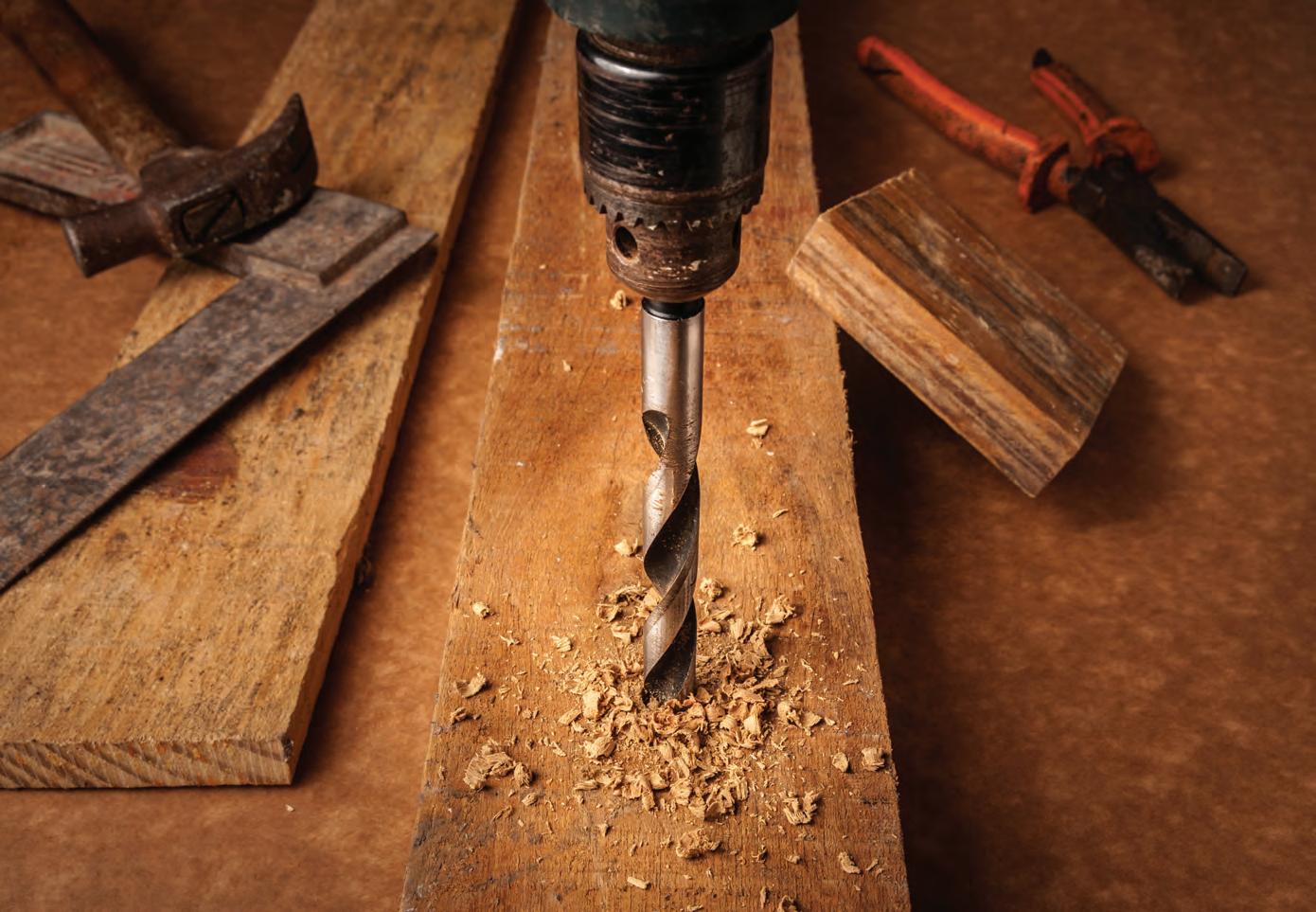








Hardlines Home Improvement Quarterly is published four times a year by Hardlines Inc., 330 Bay Street, Suite 1400, Toronto, ON M5H 2S8. $25 per issue or $90 per year for Canada.


Subscriptions to the Continental United States: $105 per year and $35 per issue. All other countries: $130 per year. (Air mail $60 per year additional)
Subscriber Services: To subscribe, renew your subscription, or change your address or contact information, please contact our Circulation Department at 289-997-5408; hardlines@circlink.ca.
Canadian Publications Mail Agreement # 42175020
POSTMASTER: Send address changes to Hardlines Home Improvement Quarterly, 330 Bay Street, Suite 1400, Toronto, ON M5H 2S8.
editorial contents
No content may be reproduced without prior permission of the publisher.
EDITOR Geoffrey
CONTRIBUTING WRITERS Allan
John
Lyndon Madden Wanda
Rob
VICE PRESIDENT & PUBLISHER David
MARKETING & EVENTS MANAGER Michelle
ART DIRECTION
ACCOUNTING
FOURTH QUARTER / 2020 • VOLUME 10, NO. 4 330 Bay Street, Suite 1400, Toronto, ON M5H 2S8 • 416-489-3396 HOME IMPROVEMENT QUARTERLY HHIQ is just one facet of the Hardlines Information Network. Since 1995, we’ve been delivering the most up-to-date information directly to you online, in print, and in person. Find out how you can get your message out with us. Contact: NUMBER ONE IN THE HOME IMPROVEMENT INDUSTRY. ONLINE AND PRINT. David Chestnut, Vice President & Publisher 416-425-7992 • david@hardlines.ca @Hardlinesnews • www.hardlines.ca www.kingmkt.com 877 844 5464 Advantage. Your brand. As manufacturer’s agents our sales representatives and merchandisers ensure your products are always “front of mind” with the hardware buyer and “front of shelf” in the stores. KING MARKETING LT D King’s brand ambassadors give our represented manufacturers an unfair advantage.
All
copyrighted 2020 by Hardlines Inc.
PRESIDENT Michael McLarney mike@hardlines.ca EDITOR Sigrid Forberg sigrid@hardlines.ca ASSISTANT
McLarney geoff@hardlines.ca
Britnell
Caulfield
O’Brien
Wilbrink
Chestnut david@hardlines.ca
Porter michelle@hardlines.ca
Shawn Samson TwoCreative.ca
accounting@hardlines.ca
Not normalyouradd.
You + the Home Hardware family.
“Joining Home Hardware has given me everything I expected from a banner - and then some. Home has a name that customers know and recognize, with flyers that truly help bring in business, a fantastic variety of products and pricing that always keeps us competitive. Now I can take on any other merchant in the industry. I’m proud to call myself a Home owner - and you will be too.”
Michelle Gerrard Neepawa, MB
Now that’s an add we can get behind.
Visit home-owner.ca to learn how you could benefit by joining Home.
HOME-OWNER.CA 100% CANADIAN OWNED
NEWSROUNDUP


BMR’s virtual fall trade show makes way for new ERP system



Western association encourages consumers to “shop local”
NHPA affirms commitment to industry diversity in policies, training
NHPA survey measures impact of COVID-19 on dealers




Lowe’s CEO Marvin Ellison urges retail leaders to “do more”

Orgill partners with tech company for online Fall Market




Housing market to see a historic recession in 2020

5 FOURTH QUARTER / 2020 DEPARTMENTS
12 CONTENTS FOURTH QUARTER / 2020 VOLUME 10, NO. 4 7 THE FUTURE OF HOME IMPROVEMENT FINDING THEIR FOOTING RETAIL TRENDS
As more and more Canadians
dealers
ways
sales with
42 60 HARDLINES MARKS 25 YEARS 24 LEADERS’ FORECAST DESPITE UNCERTAINTY, INDUSTRY LEADERS SEE OPPORTUNITIES Industry leaders share
their
words
believe 2021 has
store for this industry. 48 EDITOR’S MESSAGE Twenty-five and still alive PRESIDENT’S NOTE You read it in Hardlines SOCIAL MEDIA CORNER One click away from your community PRODUCT SPOTLIGHT Reusable sanding block, LED lighting and more BEST PRACTICES Rewarding loyalty NEWS SPOTLIGHT Lowe’s new Calgary-area DC will be biggest in Western Canada MERCHANDISING Using data to drive profitable choices SELLING TO PROS Down, but not out STORE MANAGEMENT Communicating across generations ENDCAP You can go home again COVER STORY In this feature, we’ve drawn on our years of knowledge and archives to mark how far this industry has come since 1995. 9 46 54 56 10 18 58 we’ve got this These young leaders in home improvement are full of fresh ideas and a respect for the foundations of retail. The future of this industry looks bright. 36 66
A CATEGORY IN BLOOM
found themselves staying home,
found
to grow
everything from patio sets to new varieties of plants.
in
own
what they
in
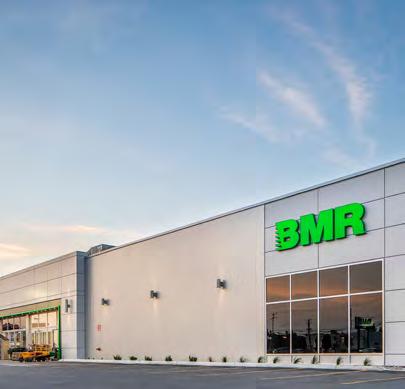 SIGRID FORBERG, EDITOR
SIGRID FORBERG, EDITOR

TWENTY-FIVE AND STILL ALIVE
You may have noticed this issue seems a little thicker than your usual send. Or maybe you haven’t because you’re reading this magazine online, due to the ongoing COVID-19 crisis.
But at 68 pages, this is the largest issue of HHIQ magazine we’ve ever produced. Like most things in a pandemic, putting it together wasn’t as easy as we try to make it look, with our team working from their home offices, scattered across Toronto and beyond.
Early this year, we had all kinds of ideas and plans for how we would mark the company’s 25th anniversary. For starters, we had some great names associated with our annual Hardlines Conference (which we had to cancel back in April). And we’d planned this super-sized issue to celebrate our birthday and to reflect on not just how far we’ve come—but how far the industry that we’ve been privileged to report on for so many years has come as well.
So much has changed in just the last six months, let alone the two-and-a-half decades since our founder launched a fax newsletter, Hardlines, from his basement office. Fortunately, this was one birthday celebration we didn’t have to abandon. We hope you enjoy our cover feature, where we analyze and reflect on the major changes the home improvement industry has undergone from all corners and coasts.
And to balance out the amount of reflection in this issue, we also have a feature
about up-and-coming retail leaders. One of those retailers, Alex Yakovyshenko from Haney Builders Supplies, told me that learning to lead at his store has had a positive impact on his life overall: “A lot of these things, I end up learning something from,” he says. “They’re helping me evolve, making me able to be a better manager; making me a better person.”
Before we knew there was a list of “essential” businesses and services, we at Hardlines knew home improvement would be on it. In the 25 years this company has been around, we’ve gathered information, interviewed sources and reported the news that impacts the industry. But more importantly, we’ve watched as home improvement dealers have helped Canadians turn
As for the future of the industry—especially following a global pandemic none of us saw coming—I’m not in the prediction business. But I think it’s safe to say it’s in good hands.
Returning to the present, on page 58, we hear from several dealers about the challenges and opportunities they’ve been managing since the pandemic hit. As product, especially lumber, grew scarce, it has seemed like every few weeks there’s been another bump in the road. But these dealers are also taking whatever lessons they can from the experience. As Scott Beaumont of Lyons Ltd. in Sault Sainte Marie, Ont., told our writer John Caulfield: “We learned that we’re pretty central to people’s well-being.”
around their worst days as they manage a flood or give them their best days as they plan an addition or renovation they’ve been dreaming of for decades.
At the end of the day, you help make home a safe, welcoming place for millions of Canadians, despite whatever is happening out in the world. Our team is so pleased to continue telling your stories as you continue to take care of business.
sigrid@hardlines.ca
Hardlines Home Improvement Quarterly www.hardlines.ca 7 FOURTH QUARTER / 2020
EDITOR’S MESSAGE
Lots of publications can’t say the same, but like the industry we serve, we’re more than just surviving—we’re thriving. (Not to brag.)
So much has changed in just the last six months, let alone the two-and-a-half decades since our founder launched a fax newsletter, Hardlines, from his basement office.
“ ”

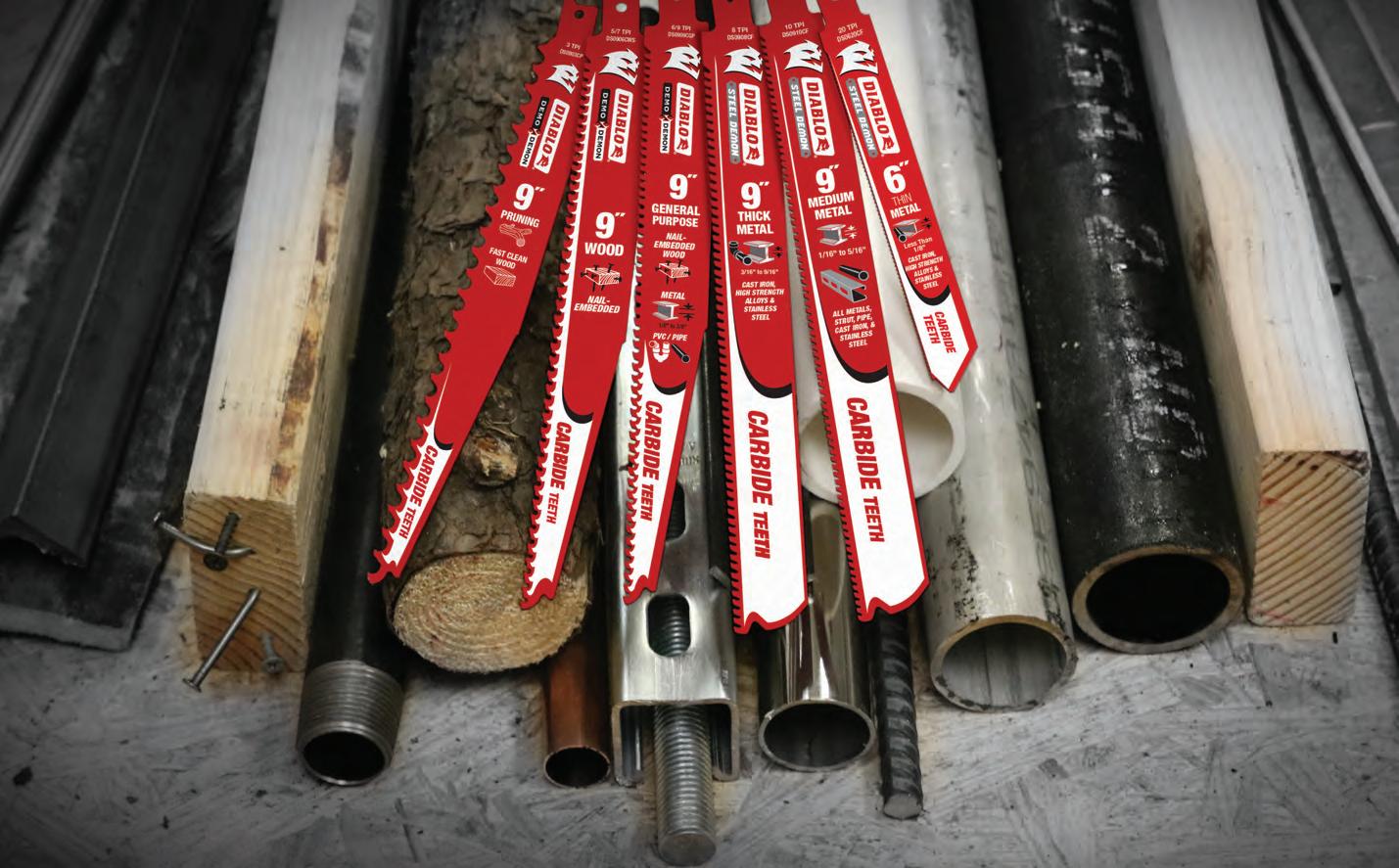





 MICHAEL MCLARNEY, FOUNDER & PRESIDENT
MICHAEL MCLARNEY, FOUNDER & PRESIDENT


YOU READ IT IN HARDLINES
Hardlines turns 25 this year. Over the past quarter-century, we’ve remained dedicated to providing news and telling stories about Canada’s retail home improvement industry. We have had a privileged vantage from which to watch this industry grow and prosper.
And during that time, Hardlines has also grown—from a fax newsletter (yes, fax!) transmitted from a tiny home office to a fullservice information and events company.
Through the years, Hardlines has been ringside for some of the biggest events to shape this industry. We were first to break the news of the sale of Beaver Lumber to Home Hardware Stores. As companies like Totem Building Supplies and Lansing Buildall pivoted to compete against the
onslaught of the big boxes, we had behindthe-scenes access to their strategies. When Home Depot Canada got its first Canadian president, Hardlines was there to interview her—before anyone else. We watched RONA’s rise from a regional buying group to a national force to be reckoned with,
that make this industry thrive. But more importantly, they are stories of individuals. People who make these companies, who have built thriving businesses and created strong retail in their communities. With those businesses, you have supported family, workers and customers to
maintaining throughout close ties with the executives at the top.
Today, we provide a number of ways to keep our industry connected. We offer everything from Daily News briefs and Breaking News to our monthly Hardlines Dealer News newsletter and HHIQ magazine four times a year—as well as our original weekly newsletter, Hardlines.
We are also proud to manage events for retailers and vendors alike, including the Annual Hardlines Conference. Today, the Conference represents the only truly national event for all banners and all segments of the industry—another thing we are very proud of.
Hardlines has a mandate to connect the industry with news and information, telling stories of the companies and successes

overcome incredible odds—long hours, staff challenges, bad weather, natural disasters, human tragedy—challenges that arise from every angle.
The urge to make a home, to create stability for family, and then improve and maintain that home, is one of the cornerstones of life in Canada. And during these difficult times, that urge has proved stronger than ever. Everyone working in home improvement retail can be proud to play such a vital role in the life of every Canadian. Hardlines, in turn, is fiercely proud to be able to report on, and promote, this industry.
Hardlines Home Improvement Quarterly 9 FOURTH QUARTER / 2020 PRESIDENT’S NOTE
Reflecting on two-and-a-half decades of reporting on this industry from a position of privilege.
Hardlines has a mandate to connect the industry with news and information, telling stories of the companies and successes that make this industry thrive.
“ ”
mike@hardlines.ca
The Hardlines newsletter was distributed by fax back in 1995


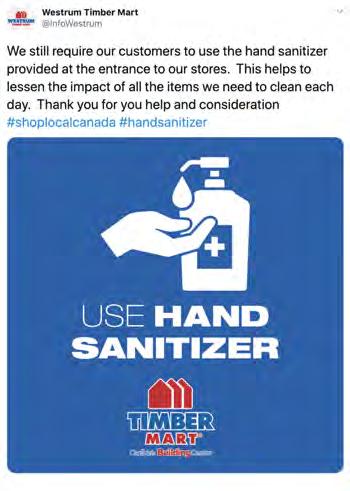


Hardlines Home Improvement Quarterly www.hardlines.ca 10 FOURTH QUARTER / 2020 ONE CLICK AWAY FROM YOUR COMMUNITY In this department, we’re highlighting a few fun and innovative ways dealers across the country are using social media to engage their communities. The best posts combine selling products with humorous and informative content. Payzant’s Home Hardware knows you can’t be too safe when it comes to COVID. #maskanything It’s all about the alcohol(-based sanitizers). #blameitonthecovid McMunn and Yates pays tribute to its roots. #hometownpride Want news updates on a daily basis, delivered right to your smartphone? Follow Hardlines on Twitter! @hardlinesnews WHAT’S TRENDING IN HOME IMPROVEMENT SocialMedia CORNER
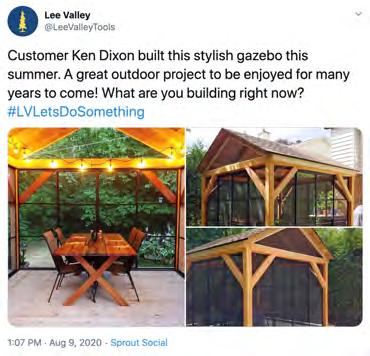

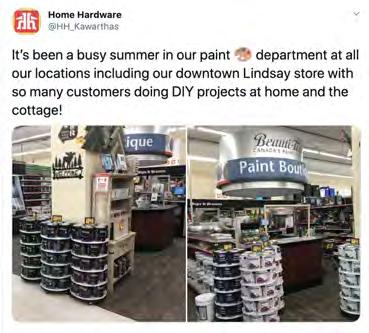

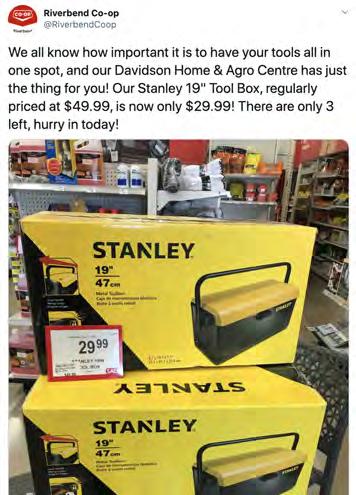


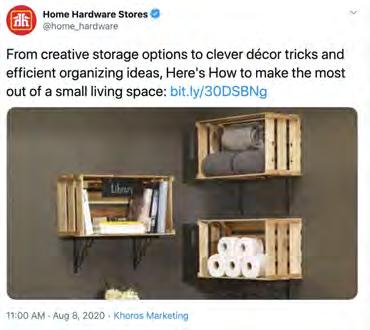
Home Improvement Quarterly www.hardlines.ca 11 FOURTH QUARTER / 2020
MEDIA CORNER
Hardlines
SOCIAL
You don’t wrap up your trip to Peavey Mart before Wonton says you can. #ikidyounot
Castle stands behind the quality of its vendors’ products. #sureofit
Lowe’s Canada nails the 2020 vibe with its ice cream day post. #thatsthescoop
ROUNDUP
OF THE HOME IMPROVEMENT INDUSTRY
BMR’S VIRTUAL FALL TRADE SHOW MAKES WAY FOR NEW ERP SYSTEM
BMR Group’s annual trade show, historically held in Quebec City over the first week of November, chose to adopt a new format and date to accommodate conditions of the current pandemic. The virtual event took place the first week of October.

When the company announced the change to dealers in mid-June, a big part of the reasoning, it explained, was that it was impossible to know at the time whether it would be realistic to hold an event for nearly 1,500 people by November, based on public health recommendations. BMR’s premonitions proved true as summer turned to fall and infection rates continued to increase.
BMR’s reasoning for moving the date up was to make way for the roll-out of a new enterprise resource planning (ERP) system. That platform, which will help the company
manage day-to-day business activities with its member-dealers, will be deployed throughout the month of November.
In acknowledging the virtual format for its show, BMR is also considering it
WESTERN ASSOCIATION ENCOURAGES CONSUMERS TO “SHOP LOCAL”
The Western Retail Lumber Association (WRLA) has launched a “shop local” campaign on social media and through its member dealers. The public awareness campaign urges people to “build up” their community by shopping at their local building supply store.

WRLA President Liz Kovach says this kind of awareness is more important than ever. While the industry is seeing a boost from sales during the COVID-19 pandemic, she warns that this situation may not last.
“There’s so much activity in the industry right now, with a lot of disruption, but I expect it to
decline in the fall,” she says. “So I think it’s really important to educate consumers on the importance of supporting our members.”
She adds that the initiative has been important to helping dealers understand the importance of belonging to an association.
“This is an important issue and it’s engaging members, regardless of their banner.” And it’s helped the WRLA recruit new members as well.
“Local businesses are the foundation of our community,” adds Kovach. “When we shop local, we are not just giving money to a giant corporation, but we are helping people in our
an opportunity for innovation. “We may be going virtual, but BMR Group plans to make this trade show as unifying and exciting as ever,” according to the letter that went out to dealers and suppliers.
community. And these local businesses in turn give back to their neighbourhoods through sponsorships, fundraisers and volunteering.”
Hardlines Home Improvement Quarterly www.hardlines.ca 12 FOURTH QUARTER / 2020
NEWS
Visit Hardlines.ca for breaking news in the Home Improvement Industry
BMR’s annual trade show, which typically draws hundreds of attendees to Quebec City, took place online this year.
NHPA AFFIRMS COMMITMENT TO INDUSTRY DIVERSITY IN POLICIES, TRAINING
The North American Hardware and Paint Association (formerly known as the North American Retail Hardware Association) is introducing new programs and enhancing existing ones to help encourage diversity, inclusion and sensitivity within the home improvement retailing industry.
“Whenever we see communities facing challenges, whether it is from natural disasters, pandemics or even civil unrest, it is always the independent home improvement retailers who are front and centre helping those communities rebuild,” says Bob Cutter, the NHPA’s president and CEO. “We thought that by making some simple program enhancements and changes we could help ensure that these business owners help rebuild their communities both literally and figuratively.”
To fulfil this mandate, the association has established a scholarship for its Retail Management Certification Program designated to benefit a member of a minority group who demonstrates an interest in furthering their career in the home improvement industry. The NHPA Retail Management Certification Program is a college-level training program designed to prepare owners and high-potential employees with leadership, management and store operations training.
In addition to the scholarship, the NHPA is adding a culture and diversity awareness session to both the Retail Management Certification Program and the Foundations of Leadership training course.

“Since these programs are designed to help guide and educate future industry leaders, it is NHPA’s belief that this addition to the curricula will better equip future leaders to recognize issues of inequality or racism in the workplace and embrace the strengths that can come through building a diverse team,” Cutter says.
“I believe we need to hold up the values of compassion, empathy and equality for all as the foundation of how we conduct business and the principles of how we operate our association,” Cutter says. “We know that none of these actions will solve the systemic problems we are seeing in our country right now, but we want to play whatever small role we can to move our company, our members and the nation in a positive direction.”
(For more information on the NHPA or its training programs, visit nrha.org.)
BRIEFLY
TORBSA ANNOUNCES NEW PRESIDENT
TORBSA has appointed Paul Williams as its new president, replacing General Manager Bob Holmes. Holmes helmed the group for 26 years. Board member Greg Drouillard, speaking on behalf of the group’s board of directors, said in a statement that Williams’ appointment “means exciting times for TORBSA to be in transition mode for more growth, with the beginning of a new era.”
HOME HARDWARE NAMES NEW LEAD HARDLINES MERCHANT
Home Hardware has named a replacement for the company’s senior hardlines VP, Joel Marks, who retired this past spring. Rob Szekszer has been appointed vicepresident, merchandise hardlines. Szekszer joined Home Hardware as director, merchandise hardlines in September 2019. Previously, he held VP and director roles at Canadian Tire Financial Services and Canadian Tire Retail. There, he worked in product and marketing, credit card marketing, customer acquisition and new business development.
LOWE’S CANADA OFFSETS PLASTIC BAGS
Since it began charging customers for plastic bags at its corporate stores in 2018, Lowe’s Canada has managed to reduce the use of plastic bags by 58 percent, or about 10 million bags. All profits from plastic-bag charges are donated to the Nature Conservancy of Canada. Between June 2018 and December 2019, these profits amounted to more than $125,000.
www.hardlines.ca 13 FOURTH QUARTER / 2020
KNOWLEDGE IS POWER. Stay in the know every single week with HARDLINES. Subscribe online at Hardlines.ca
Hardlines Home Improvement Quarterly
The NHPA will be enhancing its program offerings to make them more accessible for all members of the home improvement retail industry.
ROUNDUP
NHPA SURVEY MEASURES IMPACT OF COVID-19 ON DEALERS
In the midst of the COVID-19 pandemic, the North American Hardware and Paint Association (NHPA) deployed a COVID-19 Business Impact Survey. In total, nearly 300 independent home improvement operators representing roughly 1,500 storefronts participated in the survey, shedding light on the obstacles and opportunities the pandemic has brought to the industry. And while the majority of respondents were from the U.S., conditions they reported were reflective of the impact of the crisis in Canada.
“Now that everyone has been living in this environment for a few months, we wanted to understand the impact COVID-19 has had on independent home improvement businesses from a performance perspective and an operational perspective,” says Dan Tratensek, executive vice president of NHPA.
Compared to the same period in 2019, nearly 72 percent of retailers said sales rose
at their businesses amid COVID-19. On average, retailers said sales rose during the period by about 17 percent.
Additionally, more than 90 percent of surveyed retailers said COVID-19 had some impact on their overall sales performance, cementing the pandemic as a major challenge.
Roughly 45 percent of survey respondents had employees who opted not to work at the store during the outbreak. More than onethird were running their businesses with fewer employees. Fewer than 15 percent of respondents furloughed or laid off employees.
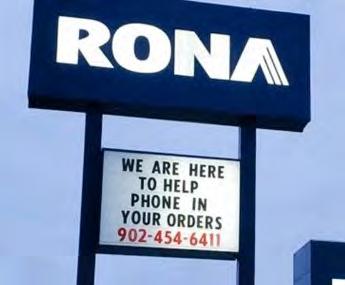
“The number of operators who have furloughed or laid off employees is still relatively small,” Tratensek says. “It looks like most of the reasons for laying off or furloughing employees centre around areas of the businesses that couldn’t function during COVID-19, like remodelling crews or delivery teams.”
LOWE’S CEO MARVIN ELLISON URGES RETAIL LEADERS TO “DO MORE”
In a virtual event hosted by the National Retail Federation in the U.S., Lowe’s president and CEO Marvin Ellison discussed how the big box home improvement chain is adapting to serve customers during COVID-19, prioritize shopper safety and respond to nationwide social movements.

In addition to Lowe’s response to new employee and shopper needs during the pandemic, Ellison discussed how social justice movements across the world are impacting the home improvement chain. He spoke about growing up in rural Tennessee and later advancing to become one of only five Black CEOs of a Fortune 500 company.
Ellison recounted a lesson his father had taught him: “Sometimes, you have to decide to talk less and do more,” he said. That tenet has guided his time at Lowe’s, where executive team diversity has grown in recent years. He added that it is “mentally exhausting that in 2020, we’re still discussing racial injustice.”
The company is also giving more than $25 million in grants to small businesses owned by members of minority groups. Ellison said Lowe’s received more than 110,000 applications since the program started. The swell of applications shows there’s a true need for support at the ground level for many businesses, he added.
The NHPA’s research also found the vast majority of respondents were instituting physical distancing at their stores. Nearly 70 percent of retailers provided personal protective equipment (PPE) to their employees. Almost 36 percent of retailers offered incentive pay to employees during the pandemic.
Retailers adjusted their operations in myriad ways, but one of the clearest developments was the growth in curbside pickup services. More than 71 percent of retailers said they instituted it in their stores. Supporting that business model was a simultaneous growth in online orders, which almost half of all respondents reported.
“That’s my challenge,” Ellison said. “Let’s stop talking. Let’s start doing.”
Hardlines Home Improvement Quarterly www.hardlines.ca 14 FOURTH QUARTER / 2020 NEWS
ORGILL PARTNERS WITH TECH COMPANY FOR ONLINE FALL MARKET


Orgill, Inc. partnered with Zoom, the industry leader in online video communications, for its e-Volution online buying event. The company says integrating the platform’s meeting technology into the event made it a more immersive and interactive experience for attendees.
This was the company’s first e-Volution online buying event, and took place August 24 to September 4.
Retailers were able to see calendar availability for vendors, schedule meetings and initiate Zoom video conferences all within the e-Volution framework.
“Our systems will completely manage the availability of all the participants, and their respective time zones, and allow retailers to easily schedule time with Orgill vendors during the two-week event window,” Marc Hamer, Orgill’s executive vice president and
chief digital information officer, said when initially announcing the online format.
Dealers also had the option of including their Orgill sales representative in meetings they scheduled to allow them to have a completely interactive experience.
Because the Zoom software was integrated into the e-Volution platform, Hamer said that participants were able to use the video conferencing capabilities even if they do not have their own Zoom account.
“Because this is the first time we have ever held an event like this, we weren’t quite sure what to expect,” says Boyden Moore, Orgill’s president and CEO. “Now that it’s over, I can say that we couldn’t be more pleased with the results. While we knew this event could not replace the entire live Orgill Dealer Market experience, based on the results, it was clear that customers and vendors embraced the concept.”
BRIEFLY
FCL GIVES BACK TO COMMUNITIES
Members of Federated Co-operatives are funding 17 projects this year through the Co-op Community Spaces program. The program is providing $1 million for local projects including a greenhouse to increase access to fruits and vegetables for low-income families in Nanaimo, B.C.; an animal therapy program in Lacombe, Alta.; a pump track in Regina, Sask.; and an interactive heritage education centre in Richer, Man. FCL administers the program on behalf of the more than 160 retail co-ops across Western Canada.
LOWE’S CANADA STEPS UP FOR ITS COMMUNITIES
Lowe’s Canada’s corporate store network has made $245,000 worth of donations over the past few months to more than 75 charitable organizations in the communities that it serves. “With the pandemic causing new problems to emerge and exacerbating existing issues, we felt it was important to express our solidarity by supporting community organizations that are facing higher demand and declining resources,” said Lowe’s Canada’s JeanSébastien Lamoureux, senior VP, public affairs, asset protection and sustainable development.
WRLA CHANGES THE NAME OF ANNUAL SHOW
The Western Retail Lumber Association has announced the name change of its Buying Show to the WRLA Building & Hardware Showcase. The new name reflects the evolution of the WRLA’s member businesses, and the goals of attendees. “The show has naturally evolved over the years and we are continuing to adapt and strengthen it to better represent the ways our members do business nowadays,” President Liz Kovach said in a release.
Hardlines Home Improvement Quarterly www.hardlines.ca 15 FOURTH QUARTER / 2020
Orgill reports its e-Volution buying event was its most successful market ever.
HOUSING MARKET TO SEE A HISTORIC RECESSION IN 2020
HOME DEPOT CANADA, LOWE’S CANADA GARNER RECOGNITION FOR SUSTAINABILITY EFFORTS
Through its ENERGY STAR program, the federal government has partnered with countless industries and companies through the years to raise awareness of energyefficient products. The program is managed through Natural Resources Canada, which gives out its ENERGY STAR Participant awards each year. The Home Depot Canada has been a participant in the ENERGY STAR Canada program since 2001. This year, Home Depot Canada won the latest ENERGY STAR Canada award for Retailer of the Year. And Lowe’s Canada received the 2020 ENERGY STAR Canada Special Recognition Award for its commitment to offering thousands of products with a smaller environmental footprint through its ECO program.
The latest forecast from Canada Mortgage and Housing Corp. about the growth of the housing market in the second half of 2020 offers some sobering data. CMHC’s Housing Market Outlook takes into consideration the impact of the COVID-19 pandemic on the economic outlook both provincially and nationally. It says housing is subject to “considerable risk” given the rapid growth and duration of the pandemic, the speed at which the global economy and financial markets are reacting and what it calls “significant regional disparities in economic impact on housing markets.”
The result? “Canada will experience a historic recession in 2020 with significant declines in all housing indicators,” says the report. “Severe loss in household income and employment, and migration at a standstill, contribute to unprecedented falls in construction activity and sales. The decline in housing activity is compounded
in oil-producing provinces as the energy sector is also experiencing historic lows.”
There is some good news in the forecast, but not until well into next year. Declines will continue this year, but housing starts, sales and prices are expected to start recovering by mid-2021 as the pandemic recedes. However, the recovery will be slow, the report warns. Sales and prices are still likely to remain below their pre-COVID-19 levels right through the end of 2022.
The slowdown in residential construction, particularly in Quebec and Ontario, will result in a decline of 51 to 75 percent in national housing starts in the second half of 2020. Recovery is expected to begin in the first half of 2021 as economic conditions improve.

CMHC does not expect existing home sales to fare much better. According to the report, “Large declines in employment and household disposable income will cause large reductions in demand for
BMR CHOOSES LOCAL FOR MEDIA SPENDING
BMR Group has announced that it will devote close to 95 percent of its media investments for a year to local media. The media plan will be based on BMR Group’s existing strategy for digital platforms and traditional media. It will be developed through partnerships with local media players such as Transcontinental and Cogeco, local radio stations and Quebecor.
existing homes in 2020. Listings will fall in response to weaker demand, placing significant downward pressure on existing home sales.” Sales are expected to decline by anywhere between 19 and 29 percent from their pre-COVID levels. The average price for existing homes will decline by between nine and 18 percent.
A gradual recovery in resale activity, coupled with a rise in prices, is anticipated to begin in 2021.
Hardlines Home Improvement Quarterly www.hardlines.ca 16 FOURTH QUARTER / 2020
NEWSROUNDUP
BRIEFLY
CMHC is expecting Canada to experience a “historic recession,” which will impact housing stats in the second half of 2020.





 BY
BY
ProductSPOTLIGHT
Techniseal Wood Stain & Sealer
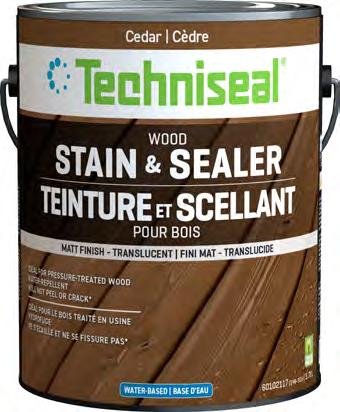
Techniseal’s maintenance-free Wood Stain & Sealer is a semi-transparent protector specially formulated to beautify and extend the life of pressure-treated wood. Made from stabilized linseed oil and nanocrystal pigments, it leaves a translucent matte finish. Wood Stain & Sealer prevents deterioration caused by harmful UV rays, mould, acid rain and freeze-thaw cycles. The water-based, environmentally friendly product doesn’t release unpleasant fumes. www.techniseal.com
DAP DYNAFLEX ULTRA Advanced
Liteline SHADE LED Light

Liteline’s SHADE LED Light strikes the perfect balance between LED lighting performance and a decorative presence in boardrooms, reception areas and hotel lobbies. SHADE is available with a choice of a white or black exterior and five interior reflector colours, with both offering custom colour options. Using leading lighting technology, including selectable CCT and wattage, SHADE is available in nine sizes and three mounting options. www.liteline.com
Exterior Sealant
From DAP, DYNAFLEX ULTRA Advanced Exterior Sealant for Windows, Doors, Siding & Trim is powered by WEATHER MAX Technology for long-lasting all-weather protection. It provides strong UV resistance against colour fading, yellowing, cracking, chalking and crumbling so the sealant stays looking new. Once cured, the surface resists dirt build-up and water absorption for a durable, waterproof seal that resists mould, mildew and algae for the life of the sealant. It has strong, multi-material adhesion and stays permanently flexible to endure expansion and contraction caused by sun, heat, cold, wind and rain. www.dap.ca
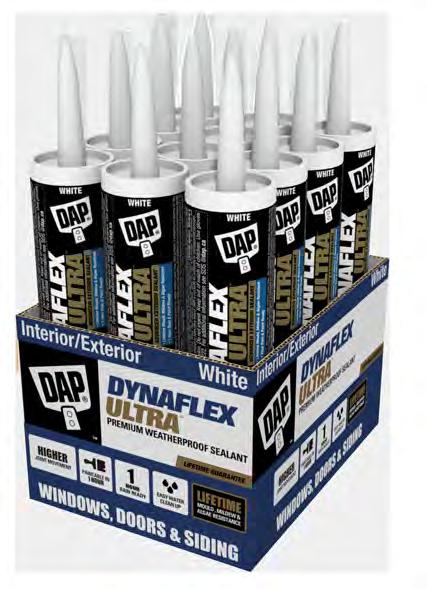
Hardlines Home Improvement Quarterly 18 FOURTH QUARTER / 2020
GEOFFREY McLARNEY
www.hardlines.ca

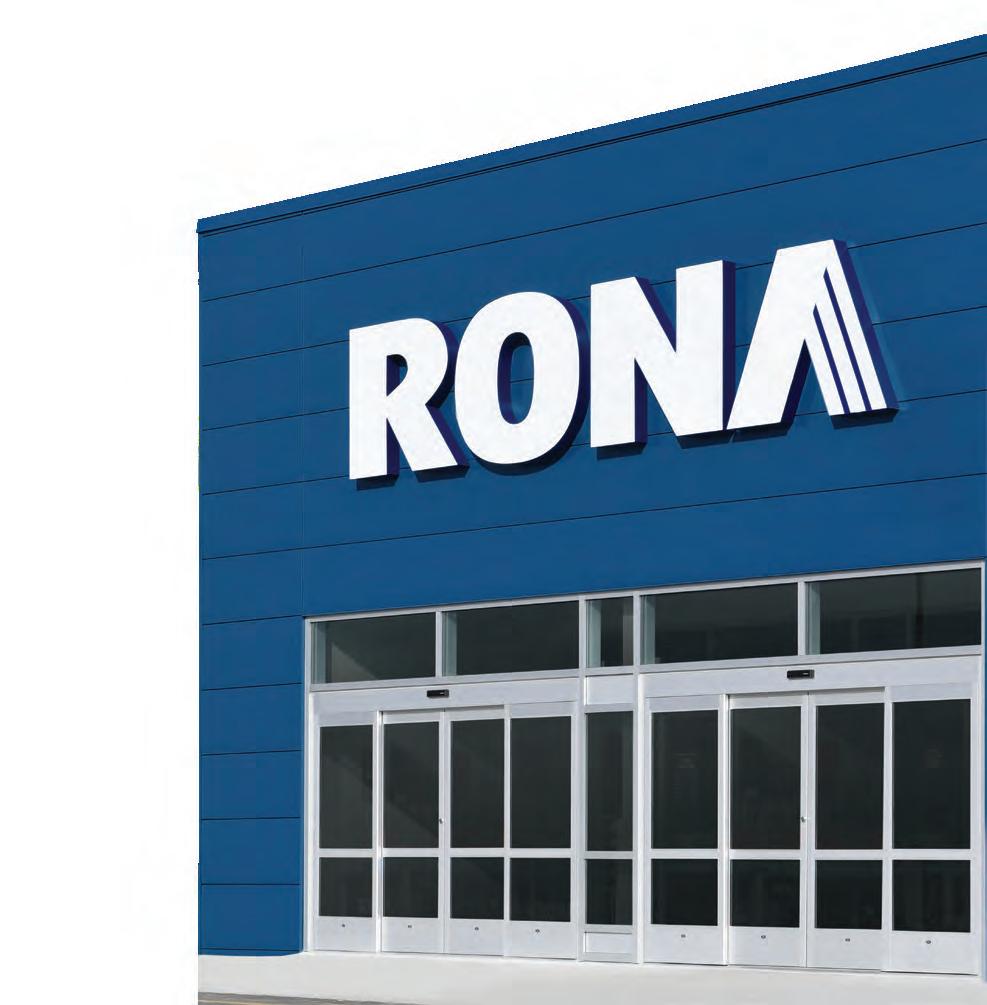
“ We were looking to enhance our business by accessing a wider selection of products and vendors, participating in the best flyer program, and offering our customers the possibilty of buying online. RONA hit all the targets on what we wanted to do. ” DISCOVER THE ADVANTAGES OF RONA, VISIT rona.ca/becomeRONA WESTERN CANADA & ONTARIO Josee Desrosiers I 418-391-7101 QUEBEC & ATLANTIC Styve Legault I 514-206-1778 BE PART OF SOMETHING BIGGER. Join us now: becomeRONA@rona.ca Andrew Neustaeter, RONA La Crete, Alberta RONA dealer since 2019
Diablo Reusable Hand Sanding Block
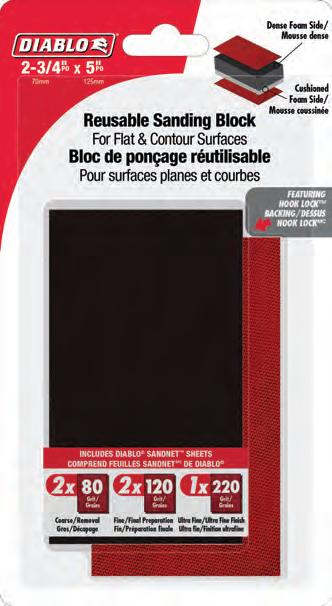
LP Elements Performance Fencing

LP Elements Performance Fencing installs just like wood, but no special tools are required. Pickets can be butted up to one another for true privacy with no swelling, twisting, cracking or warping. LP Elements is extreme weather-tested against wind, heat, rain, humidity and high impacts—even baseballs up to 80 kilometres per hour. Each colour is finished with a naturallooking wood-grain appearance. www.lpcorp.com
Exchange-A-Blade Hole Saw Kits
Exchange-A-Blade has launched three new hole saw kits to the market: 9 PC Electrician’s, 9 PC Plumber’s and 12 PC General Purpose. The premium M3 industrial grade, bimetal hole saws cut everything from wood and plastics to aluminum, steel, cast iron and stainless steel. The 4/6 tooth per inch configuration allows for easy chip removal and faster, cleaner cuts. These hole saws have been rigorously tested to more than 90 holes in 3/16” steel plate. The extra-deep body allows for 1 5/8” cutting depth and together with a heavy duty 3/16” backing plate for added strength and stability prevents mandrel run out. www.exchangeablade.com
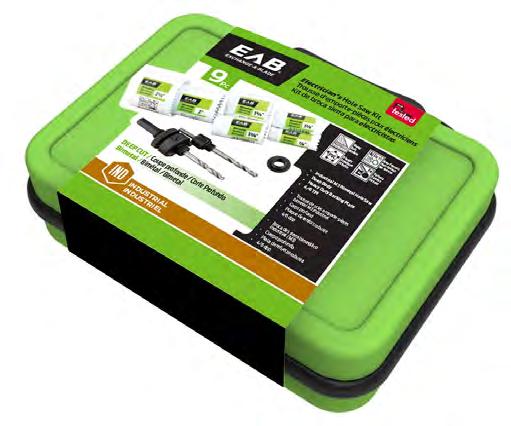
Diablo’s new Reusable Hand Sanding Block enables professional users to sand flat and contour surfaces with one tool. The premium foam tool includes two sides: cushioned for controlled material removal in contour sanding, and dense for aggressive material removal on flat surfaces. Hook Lock backing allows repeated attachment and removal of Diablo SandNET sheets. Included with the block are five SandNET sheets, ranging from coarse/removal to ultra-fine finish. The reusable SandNET nylon design is easy to clean and reuse multiple times: simply shake, vacuum or rinse to remove any build up. www.diablotools.com Hardlines Home
eguiar’s Hybrid Ceramic Wax
From 3M, Meguiar’s Hybrid Ceramic Wax uses advanced SiO2 hybrid technology for easy-to-use ceramic protection for cars. After washing and rinsing, simply spray on the wax, then follow with a second rinse using a strong stream of water to spread and lay down the wax evenly. The vehicle can then be dried easily, with no rubbing or buffing and no curing time.
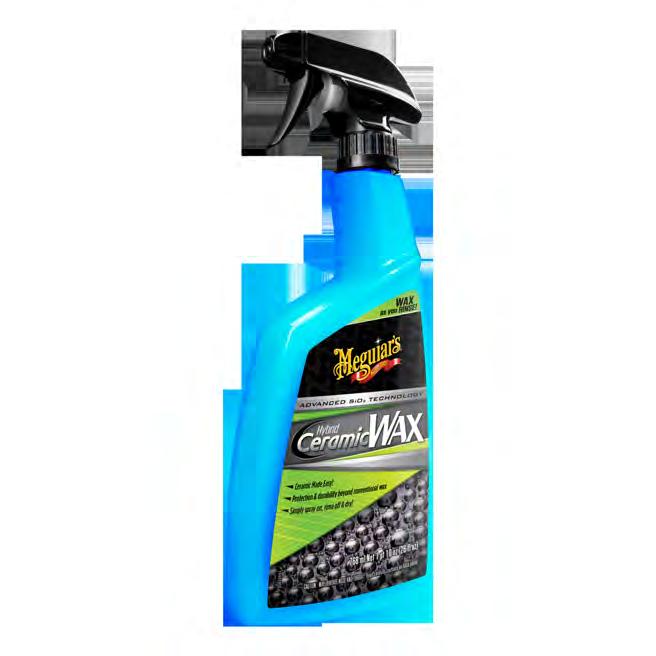
ProductSPOTLIGHT
Improvement Quarterly 20 FOURTH QUARTER / 2020
Beyond Blue

Along with a game-changing reduced global warming potential (GWP) formulation, we’re transitioning the traditional blue you have come to know to a new grey color – so you’ll know it when you see it. But some things will never change: Styrofoam™ Brand XPS performance and our commitment to your project’s success.






To get the latest information on availability, visit BeyondBlue.DuPont.com.







 Copyright © 2020 DuPont. All rights reserved. The DuPont Oval Logo, DuPont™ and Styrofoam™ are trademarks of E.I. du Pont de Nemours and Company or its affiliates.
Copyright © 2020 DuPont. All rights reserved. The DuPont Oval Logo, DuPont™ and Styrofoam™ are trademarks of E.I. du Pont de Nemours and Company or its affiliates.
Performance that stands out. Aesthetics that blend in.
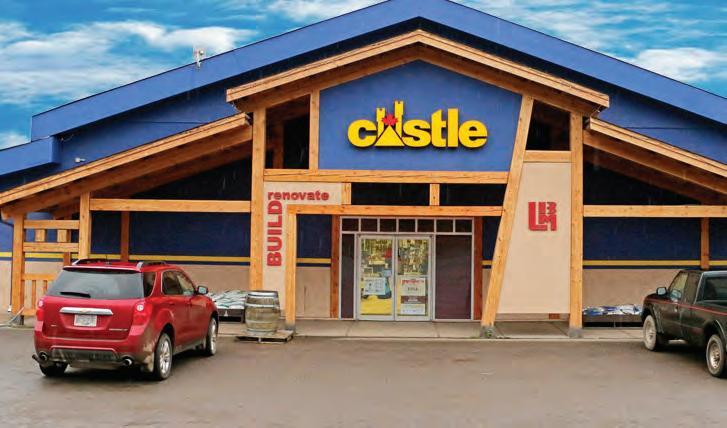

Why We Like Working With Orgill: • Knowledge about e-commerce make selling online easy • The advertising program puts us ahead of the competition • Dealer Markets and Online Buying Events offer unlimited new opportunities • The product assortment is unbeatable 1-888-742-8417 ext. 2009 contactus@orgill.com www.orgill.ca/about-us Orgill helps us with multiple facets of our business! A STRONG PARTNER
Travis Nanninga
BV
Home Centre
Two locations in British Columbia

An Orgill Customer Since 2009

“We have a truck that shows up every week on the same day with the same driver. That makes it easy for stock and special orders.”
BY THE EDITORS OF HHIQ
For 25 years, Hardlines has been reporting on the Canadian home improvement industry. The company started out as a fax newsletter, sent from our founder Michael McLarney’s basement office every Sunday evening. Now, two and a half decades later, that weekly newsletter has gone digital, and we’ve added HHIQ magazine, the monthly Dealer News newsletter, a free Daily News service and the annual Hardlines Conference. In this feature, we’ve drawn on our industry knowledge and archives to mark (and celebrate) how far this industry has come since 1995.


Quarterly www.hardlines.ca 24 FOURTH QUARTER / 2020
Hardlines Home Improvement
FEATURE

IN CONVERSATION WITH OUR FOUNDER
Hardlines President and Founder Michael McLarney started the company 25 years ago. He’s been diligently watching the industry, gathering information and reporting on it since then—he’s even planned his family vacations around breaking news. Here, we turn the tables on him and get his thoughts on everything from Sodisco-Howden to what to expect post-pandemic.

Over the years, what news took you most by surprise?
M I would have to say the fate of SodiscoHowden. As the predominant hardware wholesaler for decades, it had a dynamic growth curve over the years, buying up other competitors—names like Marchands Unis and Ace Canada. But with the growth of retail groups like Home Hardware and RONA, its power diminished. When it was purchased by Amar Doman at CanWel Building Supplies, I thought it was an odd fit. He ended up selling it to TIMBER MART, where it was renamed Chalifour Canada. The business was finally sold off to Orgill. Sodisco-Howden’s original London, Ont., distribution centre is now the site of Orgill Canada’s operations.
Was there one big news story that you feel rocked this industry?
M That had to be Home Hardware’s acquisition of Beaver Lumber. The industry had always been very dynamic, with lots of strong regional players that had carved out their markets at both the retail and wholesale level. But they tended to remain regionally or locally focused.
The number-one home improvement retailer 25 years ago was Beaver Lumber. It was the most important asset in the retail portfolio of the beer giant Molson. ThenPresident Doug Robinson was hired from the U.S. to try and sell it. But this was during the rise of the big boxes. Home Depot was the darling of the industry.

Doug told me how much difficulty he had trying to pitch the company to Bay Street. He had tried to orchestrate a management takeover himself, but family matters were pushing him to return home to the U.S. so Doug pulled away from that strategy. Home Hardware was the dark horse. And under the canny direction of founder Walter Hachborn and President Paul Straus, they managed to pick up the company for a song.
What was your toughest assignment?
M In the summer of 1999, the Home Hardware-Beaver deal was in the wind. I remember calling Walter Hachborn before going on holiday. I said, “Walter, I know you can’t tell me if the sale is imminent. I know you are bound by confidentiality agreements and can’t even confirm a deal is in the works. Just tell me this: I want to take my family on vacation for two weeks. Can I go?” There was a very long pause. Then Walter said: “Go on vacation, Michael.” I took him at his word and didn’t miss a thing while I was away. When the deal was finalized three months later, we broke the news in Hardlines.
Was there any company that you felt reflected the importance of the independent?
M TruServ Canada. It started as Macleods, one of this country’s earliest hardware banners. It became Macleod-Stedman, adding junior department stores to its mix before
these were wiped out by the growth of Walmart in Canada. Then it adopted the True Value banner through an alliance with Cotter & Company in Chicago. Through it all, I found the dealers served by this wholesaler to be exemplary of the independent spirit of small-town Canada. Most of those True Value dealers are now flying the Ace banner, which is now in the hands of Peavey Industries in Red Deer, Alta.
Looking ahead, what do you see as the next big challenge for dealers?
M Coming out of this pandemic, I am watching dealers get the hang of online selling. As their communities have come to rely on online buying during the lockdowns, dealers will have to figure out how to continue supporting their customers with ease of access and selection through online shopping to succeed. Retail groups will be challenged to empower their dealers to capture these sales as directly as possible and stop worrying about driving everything through head office. It will be an exciting time that will see bricks and mortar become more important than ever.
Anything else to add?
M One of the true pleasures of covering this industry has been the people in it. This industry is, above all, a people industry. There have been so many memorable characters over the years who have made this work fun.
Hardlines Home Improvement Quarterly www.hardlines.ca 25 FOURTH QUARTER / 2020
INDEPENDENT AND UNDAUNTED

Independent retailers have always been at the heart of the home improvement industry in Canada. The last 25 years have seen a lot of change in retail, but independents are still firmly rooted in their communities and that seems unlikely to change anytime soon.
Through the late 1990s and early part of this century, the industry’s growth typically outstripped that of retail in general. It wasn’t uncommon in those days to record high single-digit, and even double-digit, growth from year to year. The big boxes were growing fast, but the independents were firmly established, and the smart ones flourished better than anyone.
Canadian home improvement retailers benefited from the growing trend of DIY and the pride Canadians took in their homes reached crazy new heights. Where at one point, a family would renovate a kitchen just once in a lifetime, rooms became fashion statements that needed updating every few years to reflect the latest trends in finishes and accents.
For many years, the home improvement industry—and the independents at the heart of it—had benefited from being central to the communities in their small towns. The local hardware store was just as much the place you’d stop by to say hello or catch up on the town news as where you’d go to buy supplies for your home project.
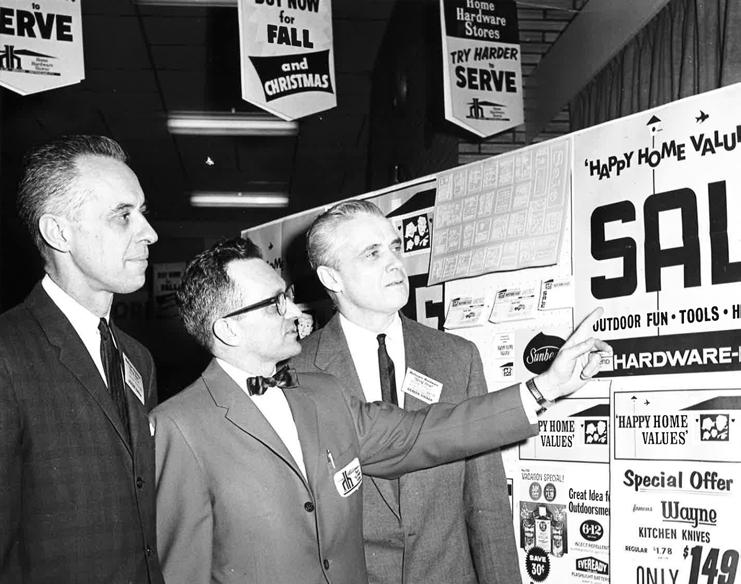
These stores were supplied primarily by one national hardware wholesaler, SodiscoHowden, as well as several regional distributors. C.N. Weber sold to dealers in Ontario, Smith-Barregar took care of independents in the British Columbia market and companies like C.B. Steers in Newfoundland and Marchands Unis in Quebec were essential parts of the supply chain.
But in 1995, change was in the air. First, The Home Depot was doing great south of the border, and just the year before, it had acquired the Aikenhead’s Home
Improvement Warehouse chain, which had five big box locations in the Toronto area. That spring, it spread West with a store in Edmonton and opened an office in Vancouver the next year—officially cementing its presence there. In just six years, the Home Depot Canada had 60 locations spread out across the country.
And the economy was faltering. The late 1980s and early 1990s were a time of high unemployment and general dissatisfaction. Following a brief recovery in 1994, Canada weathered a slump through 1995 and 1996. Housing starts were down 15 percent and mortgage rates were going through the roof—and home improvement dealers struggled as they rode out the slump.
To recover, some chains looked to grow. Home Hardware Stores Ltd. shook up the industry when it acquired Beaver Lumber in 1999. One of the best-known brands in home improvement, and one of the top four retailers at its peak, Beaver Lumber’s 138 stores became Home Building Centres and helped Home Hardware assert its position in the market.
While he’d retired from day-to-day operations a few years before, Home Hardware’s reputation was inextricably linked to its founder, Walter Hachborn. Hachborn was known for his leadership, kindness and work ethic. He was named the Canadian Hardware Retailer of the Century in 1999 and appointed to the Order of Canada a year later. Home Hardware developed a

Hardlines Home Improvement Quarterly 26 FOURTH QUARTER / 2020 FEATURE www.hardlines.ca
Walter Hachborn (centre) in the early days of Home Hardware Stores.
DEDICATION IS TIMELESS.
“Regardless of the circumstances, I know that my group is here for me whether it be in good times or uncertain ones. I can count on them to source building materials when supply is scarce or when I’ve needed to re-merchandise my store on a budget or ask a question during odd hours.
For the 50 years we’ve been a member, TIMBER MART has always been dedicated to supporting my business as it’s grown – and will always be dedicated to the independent dealer. It’s who they are –because their dedication is truly timeless.”
- Curtis Lemieux, Econo TIMBER MART, Prince Albert, SK

WEST Phil Temple 403 • 561• 8560 ONTARIO Ian Cook 416 •705 •1860 QUEBEC Daniel Rioux 514 • 237• 8697 ATLANTIC Dave Dingwell 902 • 940 • 0954
®™ Trademarks of AIR MILES International Trading B.V. Used under license by LoyaltyOne, Co. and TIM-BR MARTS Ltd. OFFICIAL HOME IMPROVEMENT PARTNER OF THE CFL
See what timeless dedication to your business is like. Learn more at www.timbermartmember.ca
Econo Lumber, 1976
Econo TIMBER MART, 2020
reputation for helpfulness, even building it into their tag line “Help is close to home” that is still universally recognizable in this country—despite the fact that the slogan has been changed a few times in the years since.

But Home was also facing stiff competition from Quebec-grown RONA, Inc. The two companies had a “gentleman’s agreement” not to target one another’s territories, but RONA acquired Ontario chain Cashway Building Centres in 2000 and Revy Home and Garden, Revelstoke Building Centres and Lansing the following year. By 2004, that agreement broke down completely as Home Hardware began to target Quebec.
The Quebec marketplace has always been an appealing area for growth. Accounting for nearly a quarter of the overall industry, it’s also been a notoriously difficult region to break into. Even more so than Canada’s other provinces, Quebecers are very loyal to home-grown brands. Lowe’s Canada’s first attempt to purchase RONA in 2012 failed due to massive public outcry from citizens, politicians and even financial institutions.
And in the years since Lowe’s made its successful second bid for RONA, companies like Home Hardware have promoted their Canadian-owned status in efforts to recruit Quebec dealers.
Over the last few years, Orgill has been stepping up its offerings for Canadians at its twice annual Dealer Markets.
FEATURE
Moving West, Winnipeg-based TruServ saw an opportunity for independents in 2001 and seized upon it. The company severed ties with its American parent to serve independents in this country autonomously. It continued to operate that way until it was acquired by RONA in 2010. RONA gave TruServ its own distribution channel to better serve smaller dealers. The TruServ banner was eventually converted to Ace Canada when RONA acquired the Ace licensing in Canada in 2014.
The dealers who continued operating under the Ace Canada banner found themselves being serviced by Lowe’s Canada following the RONA acquisition in 2016. But early this year, the license for Ace in Canada was acquired by Peavey Industries, the Western Canada-based parent company for Peavey Mart, TSC and MainStreet Hardware banners.

For true independents, Canada’s geography had long made distribution of materials a bit of a challenge. But over the last 13 years, American distribution giant Orgill, Inc. has been building up its offering for
(top and bottom right) TruServ became independent in 2001 and served independents across the country until it was converted to Ace Canada in 2014.
Canadian dealers. Its massive spring and fall shows draw hundreds of Canadians operating under mostly the Castle Building Centres and TIMBER MART banners. In 2011, Orgill formed a strategic partnership with Castle to be its preferred hardlines supplier for its members.
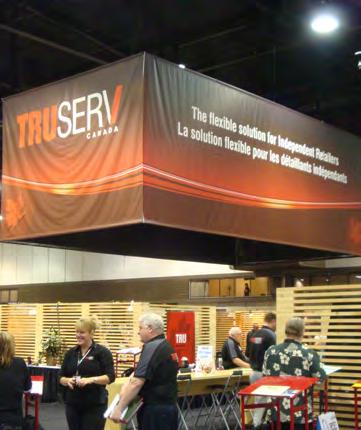

Orgill continued its growth in 2015 when it acquired Chalifour Canada, TIMBER MART’s distribution arm. The Memphisbased wholesaler set up its Orgill Canada division at the Chalifour office and distribution centre in London, Ont.
Today, independents continue to represent massive growth in the industry. In 2019, while the overall big box category saw modest growth, representing a two percent increase overall, it was the local hardware stores that saw sales growth of nearly 13 percent. The future appears bright for dealers who support the communities that support them.

Hardlines Home Improvement Quarterly 28 FOURTH QUARTER / 2020
www.hardlines.ca



















































































LANDMARKS AND MILESTONES
A lot can happen in 25 years. Here, we’ve created a handy timeline to highlight some of the major events that have influenced the industry since 1995.

1995
• T IMBER MART brands its stores, making the name more than just a rallying point for dealers to combine purchases
• Kent opens its third big box, as it braces for the arrival of Home Depot in the Atlantic Market


• Home Depot Canada opens a western office in Vancouver, establishing itself firmly as a national player that was here to stay
2007
• O rgill CEO Ron Beal speaks at the Hardlines Conference, revealing that his company is already starting to sell to dealers in this country
2010
• T IMBER MART acquires CanWel Hardware (formerly SodiscoHowden) from CanWel Building Materials
• R ONA buys TruServ Canada in Winnipeg, giving it a distribution channel to better serve smaller dealers
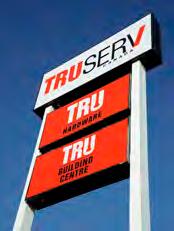

1996

• T he first-ever Hardlines Conference in October
2011
• O rgill cements strategic partnership with Castle to become preferred hardlines supplier for its members, combining forces with Orgill to promote the U.S. company’s presence in Canada

2006
• L owe’s sets up office in Canada; begins opening stores the following year
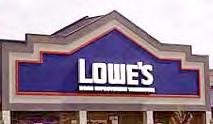

2012
• R ONA CEO Robert Dutton ousted, ending a visionary, idiosyncratic and uniquely personalized regime
Hardlines Home Improvement Quarterly www.hardlines.ca 30 FOURTH QUARTER / 2020 FEATURE
1999
• H ome Hardware completes the acquisition of Beaver Lumber, shaking up the industry and establishing the company as a serious player in the nowrapidly changing marketplace

• W alter Hachborn awarded the Order of Canada; also named “Retailer of the Century.” He would remain the company’s figurehead until his death in 2016

2004
• B reakdown of genlemen’s agreement between RONA and Home Hardware as Home targets Quebec


2003
• H ome Depot Canada opens 100th store in Thunder Bay, Ont., under the leadership of the retailer’s dynamic president, Annette Verschuren

• R ONA buys RenoDepot, a major step in absorbing competitors
2015
2014• TruServ Canada switches to Ace banner after RONA gets license to Ace in Canada
2000
• R ONA buys Cashway, a major Ontario chain with 61 stores


• H ardware wholesaler SodiscoHowden buys Western distributor Smith-Barregar, establishing itself as a true national player
2001
• TruServ Canada severs ties with its U.S. parent, becomes autonomous, serving independents from its HQ in Winnipeg
• R ONA continues its buying spree, this time acquiring Revy, its biggest purchase yet, making RONA a $3 billion enterprise
2002
• R ONA goes public, getting the financial resources to expand more aggressively than ever
• H ardlines releases survey, with ACNielsen Canada, revealing women account for more than 80 percent of buying decisions for home improvements. Home Depot and Canadian Tire among the retailers who begin focusing more on this segment
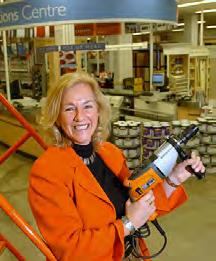
2016
• L a Coop fédérée completes takeover of BMR, resulting in the largest Quebec-owned home improvement retail group in the province


• T IMBER MART completes sale of Chalifour hardware distribution business to Orgill
• L owe’s buys RONA
2020
• C OVID pandemic hits the world, the industry responds
Hardlines Home Improvement Quarterly www.hardlines.ca 31 FOURTH QUARTER / 2020
OUTSIDE OF THE BOX
The history of big box home improvement stores in Canada is a colourful one, but the ones that got it right are now among this country’s strongest retailers.
Together, the big boxes make up just over 25 percent of all retail sales in the home improvement industry. But these large-surface retailers have long been perceived as a threat to the smaller banners and independents across the country.
Aikenhead’s Hardware, a chain of stores in Ontario, was one of Canada’s first big boxes. The original store, Ridout Hardware Store, was founded in Toronto in 1830. Two employees bought into the company 40 years later and it was run under Ridout, Aikenhead & Crombie. Ultimately, James Aikenhead bought out his partners in 1893 and ran it under the name Aikenhead’s.
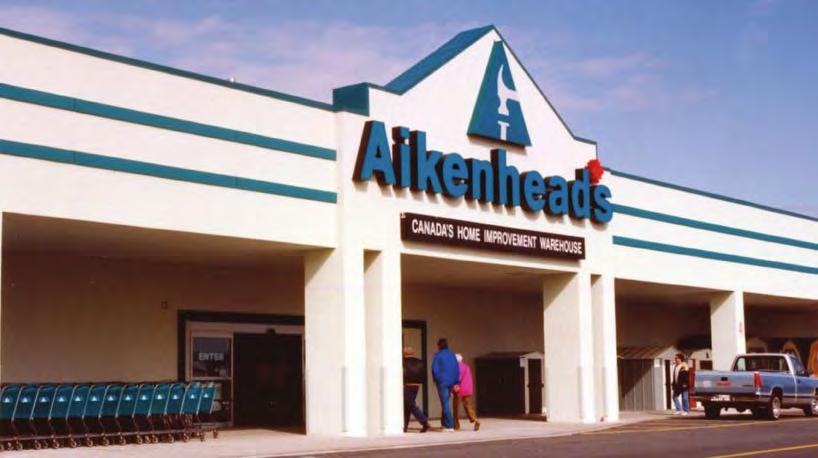
The Aikenhead family sold the business to Molson Companies in 1971 as part of its retail division, which included Beaver Lumber. Two decades later, as the industry watched the phenomenal rise of big box stores in the U.S., Molson started opening large format stores under the name Aikenhead’s Home Improvement Warehouse. For a few years, it enjoyed the distinction of being Canada’s leading big box retailer. But by 1994, Molson ended up selling the majority of the Aikenhead’s business to Home Depot and its stores became the American juggernaut’s first Canadian outlets.
In 1995, when Home Depot’s U.S. parent company bought Aikenhead’s, it announced it could eventually erect as many as 50 big boxes in Canada. That number 25 years ago sent the industry reeling, as people tried to figure out which markets could sustain The Home Depot’s large footprint formula.

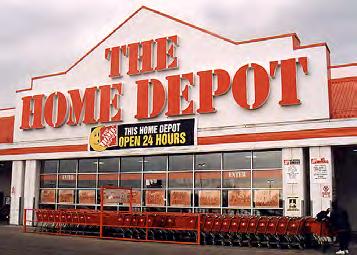
But before Home Depot arrived, other homegrown banners besides Aikenhead’s were trying their hand at the big box concept. The Revy banner, a spinoff of
Revelstoke Home Centres, a chain of home centres based in Western Canada, quickly proved to be the main competitor to The Home Depot’s ascendancy in Canada. The company was opening big boxes in major cities, with a total of seven planned by the end of 1995. It made gains with the exit of another U.S. invader. Eagle Hardware & Garden, based in Washington state, opened two stores in Edmonton in 1994 but withdrew from Canada a year later, selling the stores to Revy. Lowe’s bought Eagle’s U.S. business, which had grown to 32 stores in nine states, in 1998.
In Quebec, a privately-owned chain of building centres began its own big box rollout. Réno-Dépôt was the brainchild of Groupe Val Royale, in partnership with Molson. By the end of 1995, it had three stores of its own, all in Quebec. That year, there were only 30 big boxes in Canada, with Aikenhead’s in the lead with 19 stores, followed by nine Réno-Dépôt stores and three under the Revy banner. RONA had just two big boxes of its own then. Total
sales that year for those 30 stores were less than a billion dollars.
But it was also a tough year financially for everyone—the slowdown in the Canadian economy was slowing expansion for companies like Revy. By 2001, Revy, which operated under the Revy, Revelstoke and Lansing banners, was acquired by RONA and the Quebec chain boosted its big box count to 46. Through its acquisition of Aikenhead’s from Molson, Home Depot had right of first refusal to buy Réno-Dépôt, but backed away because of that company’s involvement with unionized workers, something Home Depot had no interest in.

Hardlines Home Improvement Quarterly www.hardlines.ca 32 FOURTH QUARTER / 2020 FEATURE
Aikenhead’s was one of Canada’s first big boxes until the chain was sold to Home Depot in 1994.
The appetite for home improvement proved to be as insatiable here as it is elsewhere in the world. Today, there are 312 big boxes in this country, with sales of almost $13 billion. Home Depot Canada accounts for 182 of those stores—far exceeding its original forecast for 50 outlets. Completing its 25th year in Canada, Home Depot Canada now ranks as the country’s top retailer with estimated sales of almost $9 billion.

EXPANSION CONTINUES
Of course, fears about American chains taking over the industry didn’t end with The Home Depot’s entrance. Lowe’s Canada began opening stores in Canada in December 2007. However, despite its steady growth in Canada, the company had no presence in Quebec—which represents nearly a quarter of the size of the industry— until it acquired RONA in 2016.
It was actually the second time the company had put in an offer for the Quebecgrown business originally founded in 1939. The first offer was made in 2012, but was met with objections from RONA shareholders and franchisees and ended up falling through. However, the second offer was finalized by mid-2016 and brought RONA, Reno-Depot, Ace Canada and Dick’s Lumber under the Lowe’s Canada banner.
At first, the stores were run under their original banners, but over the first few years of the acquisition, Lowe’s Canada slowly converted the large-format RONAs to the Lowe’s banner. Lowe’s Canada now has 508 stores across the country (excluding the Ace Canada stores, which were sold off to Peavey Industries at the beginning of this year), and a solid representation in Quebec. And it ended fiscal 2019 with 121 big boxes under the Lowe’s, RONA and Reno-Depot banners here.
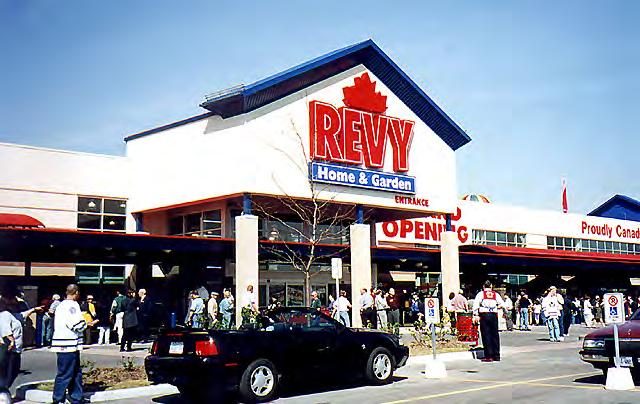
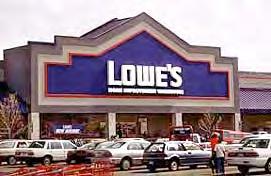
ROOM FOR REGIONAL PLAYERS, TOO
In Atlantic Canada, Kent Building Supplies remains a dominant player, with nine big box stores generating an estimated $342 million in annual sales in 2019. Kent has 49 stores on the East Coast and is a dominant player in the region. For many years, it focused on its smaller format stores and put its big box expansion on hold.

But in 2018, Kent turned its focus back to the big box format, with the opening of a 124,000-square-foot store at Dartmouth Crossing in the Halifax Regional Municipality. And then in February of this year, a report presented to the Moncton city council revealed Kent has plans to make that city the site of its 10th big box store.
According to the report, the company is aiming to open a 100,000-square-foot store by 2022, replacing a truck terminal that currently sits on the site. A second phase of the plan provides for an additional 150,000 square feet of retail space and 10,000 square feet of restaurants to be developed by 2025.
Kent’s renewed focus on the big box format, as well as the growth strategies of Home Depot Canada and Lowe’s Canada, demonstrate that there’s still room in the Canadian market for this style of retail. And with the square footage and resources to continue to develop innovative ways to serve their customers, they’re sure to remain a going concern.
Hardlines Home Improvement Quarterly www.hardlines.ca 33 FOURTH QUARTER / 2020
The Revy banner was a spin-off of the Western-based Revelstoke Home Centres chain.
Lowe’s entered Canada in 2007 and increased its market share through the acquisition of RONA in 2016.
Kent has 49 stores on the East Coast, but only nine are big boxes.
CELEBRATING EXCELLENCE IN RETAIL
The Outstanding Retailer Awards were created in 1992 to recognize and celebrate the achievements of hardware, home improvement and building supply dealers across Canada. Over the awards’ nearly 30-year history, more than 200 retailers across the country have been recognized.

As the only national awards program in the Canadian home improvement industry, the Outstanding Retailer Awards (ORAs) bring together retailers who represent all of the regions of Canada as well as all corners of the industry.

The awards were launched in 1992. Over the years, the number of annual recipients and the ownership of the awards program have changed, but the one thing that has stayed the same is the quality of applicants year after year.
“There are so many great retailers in this industry, we needed a forum to celebrate them,” says Hardlines President Michael McLarney. “We needed a way to learn their stories and share their stories so we could all get better at what we do.”
Hardlines acquired the program in 2013 and has continued to grow it over the last seven years.

After the death of Marc Robichaud, a fifth-generation retailer for UJ Robichaud TIMBER MART in Meteghan Centre, N.S., in 2012, a seventh category was introduced.
Robichaud’s untimely death at 36 years old shook the industry. Having started working for the family business while still in high school, he was known for his commitment to running an eco-minded operation and being heavily involved in his community. In his honour, the ORAs have awarded retailers from across the country and from a wide variety of banners with the Marc Robichaud Community Leader Award. Every year, the dealers nominated for this category exemplify a level of generosity and kindness far beyond the norm.
And just last year, Hardlines introduced
an eighth category. For years, the annual ORA judging panel would be moved by the stories of applicants who were outstanding but weren’t a perfect fit for the seven other categories. Hardlines President Michael McLarney created the Independent Spirit Award for these stores.
The first winners in the newest category were Marilyne and Sylvain Laferriere of Victory Building Centre in Mackenzie, B.C. The Laferrieres helped carry their town through a tough few years after the local mill closed and Mackenzie’s economy weathered a depression. “It’s a really good feeling to be recognized for what we do within our community and to also recognize those who helped us get here,” says Marilyne Laferriere.
Every year, Hardlines takes pride in the motivation, inspiration and joy the awards bring to the winners and nominees alike.
Over the years, the recognition dealers receive through the ORAs awards program has been the encouragement and the positive feedback many have needed to continue to push their business forward.
“I feel very grateful to have been honoured and hopefully I can bring that to some of my other fellow young people in the industry and inspire them to do something more in their stores as well,” says Rebecca Wichers-Schreur, the 2019 winner of the Young Retailer Award.
While the 2020 Outstanding Retailer Awards, originally scheduled for this fall, have been cancelled due to COVID-19, that just means you’ll have plenty of time to think about your 2021 application. If you’re interested in the awards, or think you might make a good applicant, find out more at hardlines.ca/oras.
Hardlines Home Improvement Quarterly 34 FOURTH QUARTER / 2020 FEATURE www.hardlines.ca
The Outstanding Retailer Awards gala is an annual event that brings together people from across the industry to honour excellence in retail.
Thank you.
Over a quarter of a century, Hardlines has covered the retail hardware and home improvement industry as it has faced challenge after challenge. Sometimes these challenges were widespread, such as the arrival of new competitors or economic downturns. But more often, those challenges have been local and personal, as you have united to support your communities through floods, forest fires, mine or mill closures, droughts and crop failures.
Today, we face quite possibly the biggest challenge of our lifetimes. Through the current COVID crisis, the people who serve this industry have exemplified the very best of who we are as Canadians, opening your doors and hearts to those in need and those less fortunate, all the while maintaining your role as business leaders for your stores, your teams—and your customers.
At Hardlines, we are proud to have been able to follow your stories during this difficult time, just as we have over the past 25 years. Our success today reflects your success as store dealers, managers and associates, along with the suppliers, service providers and associations that make up this industry. Thank you for your support. We look forward to the next 25 years together!
PRESIDENT
 VICE PRESIDENT & PUBLISHER
VICE PRESIDENT & PUBLISHER
CONFERENCE SERIES 2021 DealerNews
Michael McLarney
David Chestnut
Sigrid Forberg EDITOR
Michelle Porter MARKETING & EVENTS MANAGER
Shawn Samson ART DIRECTOR
Geoffrey McLarney ASSISTANT EDITOR
BY SIGRID FORBERG
FINDING THEIR FOOTING
These young leaders in home improvement are full of fresh ideas and a respect for the foundations of retail. Whether they were born into the industry or came into it by chance, in their hands, the future of this industry looks bright.
Hardlines Home Improvement Quarterly www.hardlines.ca 36 FOURTH QUARTER / 2020
we’ve got this
FEATURE
isters Theresa Handel and Allison Kilby both got their start in the family business, Pioneer Home Hardware Building Centre in Campbell River, B.C., when they were teenagers.

Handel jokes they were initially given the very important tasks of paper shredding, weeding, painting railings and breaking down boxes.
“My dad once said something that really stuck with me—he always believed that you never ask your staff members to do something you wouldn’t,” says Handel. “When we were younger, he really wanted us to learn by that experience. That really shaped how we are today.”
Sitting by her sister’s side, Kilby pipes up: “That’s so funny, I have that exact lesson written down too! It obviously has stuck with us both.”
Handel and Kilby are two of a threewoman team taking over their family store, previously run by their father and two uncles. While Kilby knew from a young age that running the business was what she wanted to do, Handel only returned to the company three years ago after a career in nursing.
“When I came back, I had to start from the ground up again. It’s still really important to really appreciate what your staff do day-to-day,” she says. “I needed to relearn all the roles. But not necessarily with the paper shredding—we have a company that does that now.”
MAKING THE COMMITMENT
For young leaders like Handel and Kilby, making home improvement your career means in some ways making it your life. When there’s an early morning lumber delivery, they instinctively know it’s going to fall to them. But adjusting to that responsibility was easy—they watched their dad sit at the dinner table in the evenings for hours working on the schedule or answering late-night calls from the alarm company.
“We didn’t necessarily know that was training, we just assumed it’s part of the business going in,” says Kilby. “That was just as valuable training as moving around the store and learning each of the departments.”
Tyler Dueck, owner of RONA Valley Enterprises in Rosenort, Man., also grew up in the business, seeing all that was involved in running the store. And when he headed off to school, he thought he was leaving his small town and the family business behind.
“I wanted to do something different, I wanted to go into accounting,” he says. “I told myself I was going to go travel and clear my head for a year and it took no less than about two weeks until I was kind of called back by my uncle who owned the company at the time and he said, ‘We want you to come back and we want you to buy the company.’ ”
After a bit of soul-searching, Dueck realized he would likely never find a job he enjoyed as much as working in the store. Tallying up his bad days, he averaged it out
to one in 30 and reminded himself that was an excellent ratio.
Fresh out of university, he realizes he was young to commit the next 40 years of his working life, but he has no regrets.
“What we’re selling today helps a farmer build up his business tomorrow,” says Dueck. “I really didn’t think there would be anything else that would give me more joy in that sense.”
FIGURING OUT THE INDUSTRY
For Stacy Duguay, owner of North Dundas Building Supplies in Winchester, Ont., who only just entered the industry three years ago, everything about home improvement retail was new. Duguay and her husband decided to open North Dundas Building Supplies initially as a way of growing his construction business.
“A lumberyard made sense,” says Duguay. “We go through a lot of materials.”
Duguay selected Castle as their buying group and worked with the group to plan
Hardlines Home Improvement Quarterly www.hardlines.ca 37 FOURTH QUARTER / 2020
S THE FUTURE OF HOME IMPROVEMENT
Theresa Handel (front) and Allison Kilby say they inherited their business philosophy from their father.
THE FUTURE OF HOME IMPROVEMENT
FEATURE
and stock the store. As the fourth building centre in their small town, she was concerned there wouldn’t be space in the market for another competitor. But in the two years since their doors opened, they’ve attracted and maintained a loyal clientele.
“We were skeptical of how we were going to differentiate ourselves from the other three—would we even be able to offer enough to the community so they would come to us? But we have been very successful,” says Duguay.
From day one, Duguay says, customer service was her top priority. But she was determined to approach it with complete transparency and honesty.
“We may not have something in store, but we never tell a customer, ‘No, we don’t have that,’ ” says Duguay. “Instead, it’s: ‘We don’t have it right now, when do you need it for? Let’s see if we can get that.’ Always. Because to me, the moment you say no, that kind of ends the conversation.”
Adam MacLeod, co-owner of three Home Hardware stores in southwestern Ontario, started his career in retail at 15 years old, working for Canadian Tire.
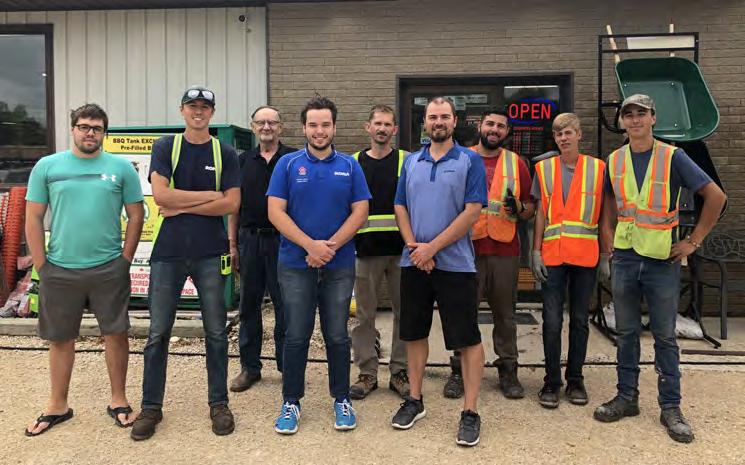
“I kind of moved through the ranks with the intention of becoming a dealer one day,” says MacLeod. “I always wanted to work for myself—I knew that at a young age. Once I got started with Canadian Tire, I thought there was a bit of prestige to the owners and
I always respected them. I wanted to be in a situation where I could coach people and teach people myself.”
But his goals changed 15 years back when he was living in St. Thomas, Ont. The mall across the street from his house was under construction. He noticed a Home Hardware sign go up at one point, and intrigued, he popped over to offer his help getting the store off the ground. He’d worked on the building process with a couple of Canadian Tire stores, so the owners hired him on as store manager and he’s been there since.
“I’m no longer living across the street from the store though,” he jokes.
FINDING THEMSELVES AS LEADERS
Having been the recipient of a career full of mentoring, encouragement and support, MacLeod says teaching has become one of his top priorities. He offers the example of a staff member, John, he just had a feeling about as he was interviewing him.
“Within about 30 seconds, I was blown away,” says MacLeod. “I knew I had somebody talented. I didn’t know what it was, but I just knew he was a fit in the organization.”
John was brought on a year ago at the St. Thomas store’s service counter. While he had no lumber experience, he was polished and professional—and most of all, eager to learn. He’s since been promoted to the company’s new position of business experience lead, where he’s responsible for carrying out all the training and orientation—something MacLeod says has been invaluable as a third store location in Komoka, Ont., was being built and staffed. John even came up with and implemented the company’s safety procedures in the early days of the COVID19 pandemic.
Kilby and Handel say they take a similar approach to hiring, going with their gut rather than looking only at experience. “We’re very choosy with who we let into our team,” says Handel. “I think, as owners, we understand that skills can be taught; personality is something that either jives or it doesn’t.”
Brandon Ford, store manager of Albertsons Home Center, a TIMBER MART dealer in Parksville, B.C., says the team aspect was what really appealed to him

Hardlines Home Improvement Quarterly 38 FOURTH QUARTER / 2020
www.hardlines.ca
Brandon Ford of Albertsons Home Center said the competitive nature of retail is what initially attracted him to his role.
Tyler Dueck (fourth from the right) and his team at RONA Valley Enterprises.
Working for our members every day.
There’s no doubt that consolidation has cut down on the number of product manufacturers. For independent dealers like me, that means less competition between suppliers for my business and less leverage for me to get more competitive pricing for my customers. That’s where I rely on Sexton’s strength to negotiate programs that keep me competitive.”
—Charlie
Hotham, Owner, Hotham Building Materials

Our Promise to You.
Our strength as a buying group is built on four major advantages: We’re a dedicated team of industry professionals focused on your success. We negotiate competitive programs and leverage our strong relationships with vendors to resolve any issues quickly for you. We have a first-class accounting team that promptly delivers accurate rebate payments as promised. Well connected. So you can focus on what matters most — your business.
Hear about our story at 1. 800.665.9209 Learn about our story at sextongroup.com
“
THE FUTURE OF HOME IMPROVEMENT
about the job. He grew up playing sports and retail offered him a great opportunity to pull together with a team in a competitive environment.
Ford started working for the company when he was just 17, as a yard associate. He worked his way through the ranks for the next four years before leaving to go back to school to train as a firefighter. But when he finished school at 21, he was offered the role of store manager at Albertsons. He thought he might try it out even just for the experience before returning to firefighting, but that was 15 years ago now.
FEATURE
CHALLENGING ONESELF
For some, being a leader means stepping outside of their comfort zone. Alex Yakoyvshenko, the manager of Haney Builders’ Supplies, a TIMBER MART dealer in Maple Ridge, B.C., was hired on to turn around an ailing store. An important aspect of improving Haney’s sales was improving its company culture.

Yakovyshenko says it was easy to create more opportunities for staff to get together and simply socialize. “I’m starting to see the value in that,” he says. More socializing wasn’t something he was initially inclined
to do, but once he began to see it pay off, something clicked.
“A lot of these things, I end up learning something from,” Yakovyshenko says. “They’re helping me evolve, making me able to be a better manager; making me a better person.”
And that lesson carries over into how he approaches mentoring his staff. He says a few years ago, if he recognized someone on his team had potential, he would simply start giving them more responsibilities. But experience has taught Yakovyshenko that while that’s a valid approach, there’s a better chance for success when you check in with your emerging leaders and ask them directly what they want to do.
But after that conversation, you need to equip them with the tools they need to succeed and set up a dynamic where they can come to you if things are working. Then you simply step back to allow them to learn.
“You have to be okay with them failing,” says Yakovyshenko. “And you have to have that conversation with them so there’s less fear around it. Celebrate the wins and learn from the losses.”
Yakovyshenko also has hard conversations about succession with his staff. As the baby boomers—one of the largest generations in Canadian history—have been retiring en masse and passing on their businesses to successors, it can bring up unexpected feelings around retirement. But at his store, he’s partnered up team members to learn the ropes for all management positions because at the end of the day, the ongoing success of the business is more important than avoiding uncomfortable conversations.
It’s advice Ford of Albertsons Home Center has found helpful as well. He suggests dealers who want to build their teams look for people who can bring something new to the organization.
“Hire people who are strong where you’re weak,” Ford says. “Don’t be afraid to hire that person that’s going to be gunning for your job. You’re going to want to have a
Hardlines Home Improvement Quarterly www.hardlines.ca 40 FOURTH QUARTER / 2020
Alex Yakovyshenko of Haney Builders’ Supplies says an important part of encouraging new leaders is allowing them to fail.
team of strong individuals to help build your company culture, so customers continue to know that you’re there for them.”
KEEPING IT REAL
Dueck of RONA Valley Enterprises says the best lesson he’s learned along the way when it comes to sales is that being great at selling people things doesn’t count for much if they just come to return it the next day when you’re not around.
“In our market, all the people here are just as educated as our salespeople,” says Dueck. “We realized that you didn’t have to be an aggressive sales guy, you could be an honest, down-to-earth guy and when you don’t know something, just tell them that you don’t know it.”
This realization changed everything when it came to approaching sales at the store. Instead of trying to look at it as tacking on items to every sale, sales staff will listen to what’s involved in the project and recommend add-ons to save customers a trip down the line. The simple realignment shows their customers that they genuinely care, and Dueck says that trust means customers return to the store for increasingly larger projects.
Dueck says he was again reminded of how important those relationships are when COVID-19 first hit. Mulling whether he’d have to close, he reached out to a few regular customers to get their thoughts. The panicked “if you close, we’ll have to close” responses from contractors and their regular consumers’ need for supplies made the decision to stay open easy.
The pandemic has served as an excellent reminder for all these young retailers of the important role their stores play in the communities they serve. But also it reasserts the overall importance home improvement plays in the lives of Canadians, as all across the country, they find themselves seeking the comfort of a safe space. And while the virus will eventually be managed, none of these retailers sees the need for what this industry provides going away.
Support from head office
The idea for Home Hardware Stores’ young leaders’ group actually came from one of its first members.
“One of our dealers reached out and said, ‘There seems to be a lot of secondgeneration dealer-owners coming up. I think it would be really great to start a group for those of us experiencing similar things,’ ” says Sherri Amos, Home Hardware’s director of dealer support.
Nearly a decade and a half later, that group has grown to include around 120 stores, often with multiple participants from each store. The only requirement to join is that the store owner approves the member’s involvement. Facilitated by a team at Home Hardware head office, including Amos, the group meets twice a year, as well as meeting up at various conferences and retreats over the year.
But the most successful thing that has emerged from these meetings, Amos says, is the private Facebook group that was formed in the early days. It serves as a platform to share ideas and is a place to find peer support.
“This Facebook group became this really safe place for them,” she says. “Someone would post, ‘Hey, we just found out an employee of ours has been stealing from us.’ Obviously the condolences would come in, but then people would chime in, ‘That happened to us, this is what we did, this is probably who you should speak to, this is how we netted out on it.’ ”
While the group has been a sounding board for some head office initiatives over the years, Amos is clear that its focus has always been on supporting dealers and giving them the connections and resources to navigate running their businesses successfully.
Home isn’t the only group that offers support to its emerging leaders. TIMBER MART hosts an annual Leadership Summit, organized by a committee of its dealers. Like Home’s group, the summit strives to balance applicable takeaways with relationship-building and fun. Brandon Ford of Albertsons Home Center is one of the committee members. Even though he’s based on Vancouver Island, Ford has made friends as far away as Halifax. In fact, through the pandemic, Ford and a group of four other dealers have kept in close touch, sharing best practices and supporting one another.
“These are unchartered waters,” he says. “The value from just that chat group with five of us involved—I feel bad for anyone who has to try to navigate this on their own.”
“With people, they always want change,” says Duguay. “Whether it’s paint or they want to renovate a room or add a room, or make more space in their house, there’s always
going to be [a need for us], people aren’t just going to move into a house and never do anything to it. That’s a huge part of our business and I think it keeps us vital.”
Hardlines Home Improvement Quarterly www.hardlines.ca 41 FOURTH QUARTER / 2020
A CATEGORY IN BLOOM
2020 has been a year of reckoning as the world wrestles with the realities of a global pandemic. Small and big businesses have struggled to figure out new norms of operation and how to keep the economy running while keeping people safe.
Yet, out of the doom and gloom (or because of it), the outdoor living category was blossoming. With homeowners on lockdown and families forced to stay put to slow the spread of COVID-19, customers focused their attention on what they could control—their home environment and how to maximize their living space by boosting the potential of their backyard, patio or balcony.
From getting back to gardening basics to outdoor movie screenings, firepits to a charcoal barbecue resurgence, customers are investing in their exterior spaces to create the outdoor oasis that suits their style and serves their needs.
BACK TO THE ROOTS
The glitz and glamour of tricking out one’s backyard like one out of a TV show inspires consumers, but there’s a subtle and pervasive back-to-basics trend popping up that focuses less on bringing the indoors outside and more on how to nurture what already exists in nature.

Enticing bees, butterflies, birds and ladybugs—those beneficial creatures critical for pollination and healthy gardens—into the
BY WANDA O’BRIEN
yard is a conscious choice that customers are making when planting.
“Bringing beneficials back into your garden and caring about beneficials” has been popular for the last few years, says Annick Robitaille, the Ottawa-based merchandise manager at Lee Valley Tools. This is especially relevant for urban centres.
“As populations grow and lots gets smaller, you don’t necessarily have the spaces for beneficial insects to hide out and be protected for the winter. They need logs and trees, and in new developments you don’t have that, so that’s where this trend came from.”
Robitaille has seen Lee Valley’s pollen bee nest, a protected space for bees to lay their eggs, grow in popularity. Similarly, hummingbird feeders and wildflower mixes targeted to attract beneficials are in demand.
Beneficial insects will also support the “grow your own” movement and the consumer drive to plant vegetable gardens, in whatever size plot or pot works for them.
“The amount of people who are putting veggie gardens in their homes is unbelievable,” says Michael Allen, general manager for the North Vancouver and Powell River RONAs. He’s seen an upsurge in people prioritizing space for a vegetable garden, even taking out landscaping like hedges or cedars to make space for garden growth.
“I think it’s a lifestyle decision that people
are making. They want to be able to pick their own spinach and make that salad out of their own garden.”
“The veggie garden is a big focus for the customer,” says Johan Dumay, BMR Group’s purchasing director. “It was a good category before, but this year it’s amazing.”
BMR launched the Botaflora fertilizer line this year, and as Dumay says, “it was the best time to launch this product.” Whether in a larger backyard or on a smaller balcony, Dumay says people are purchasing gardening products in all sizes to work with the space they have available.
At Lee Valley, the Vegepod—selfwatering planters that promote light and
Hardlines Home Improvement Quarterly www.hardlines.ca 42 FOURTH QUARTER / 2020 RETAIL TRENDS
FLE
As more and more Canadians found themselves staying home this spring and summer, dealers found ways to grow sales with everything from patio sets to new varieties of plants.
Michael Perry is a horticulture expert from the U.K. known as Mr. Plant Geek.
protect against pests—sold out early on, says Robitaille. Lee Valley first came across the product at a trade show in Germany, and the uptake in North America continues to grow as people have more time in their yards.

Michael Perry, a horticulture expert from the U.K. known as Mr. Plant Geek, also touts the Vegepod as a great example of a cutting-edge product for the wannabe green-thumber. “It’s basically an elevated allotment, giving anyone access to growing their own fruit and vegetables.”
Perry says another U.K. trend for nurturing greenery is incorporating hardy exotic plants into outdoor design. He recommends banana species that can withstand -10C, dramatic-looking cordylines and unique climbers. “They can give a real vacation vibe and the exotic plant choices give a real luxurious feel to any garden.”
CASUAL ENTERTAINING REIGNS
“The [formal] dining category is all but dead,” says Allen. People are still eating outside, but having observed the industry for 17 years now, he notes the focus has now shifted to creating “the great room” outdoors to feel at home outside of your home.
Infused with the sensibility of the California room, this is a space where people are looking to add square footage to their living experience as an extension
In
of the family room or kitchen, says Allen. Think outdoor kitchens with bar seating, televisions and firepits and big, comfy couches offering lots of extra seating with coffee and end tables.
“They’re really taking the traditional family room that we all grew up with and moving it outside. That’s where they eat and that’s where they entertain and it’s more about entertaining than it is about sitting down to have a meal.”
In 2013, the North Vancouver RONA store opened an outdoor living department, with items that include high-end patio furniture, barbecues and hot tubs. The department sales have quadrupled in seven years.

“It just shows how the consumer is committed to that space.”
West Coast weather is a selling point as it allows the outdoor investment to be enjoyed multiple months of the year, but even in Central Canada, with a much shorter outdoor season, people want fun and functionality outside.
“We started getting requests around making people’s backyards more useable,” says Ben Zlotnick, founder of both Aden Earthworks, a Toronto-based landscape design company, and Eden App, a lawn maintenance and snow removal app operational across North America. He says families are redirecting funds that would have
Quarterly www.hardlines.ca 43 FOURTH QUARTER / 2020
Hardlines Home Improvement
BMR launched the Botaflora fertilizer line this year.
2013, the North Vancouver RONA store opened an outdoor living department, with items that include high-end patio furniture, barbecues and hot tubs.
RETAIL TRENDS FLE
been spent on vacation or sleepaway camp to their local space, making a getaway that’s steps away.
“It used to be that they would go out for a Sunday night barbecue, but now they’re literally in the backyard every single day.” Pools, patios that can easily accommodate 10 people and outdoor kitchens are all in high demand.

GREAT TIME FOR GRILLERS
“There are two types of barbecuers,” says Allen. There are those who are more casual and simply want something reliable for everyday barbecuing “and then there are the grillers.” Allen says the sales for charcoal barbecues have risen as grillers create “a whole experience on the weekends” through charcoal, wood-pellet or smokers.
“I think that is going to be the way of the future,” Allen says. “It’s more natural cooking and people really enjoy it. As the experience outside your home gets better, people are going to find more ways to spend time outside and that’s just one of the ways of doing it.”
Particularly in households that have more than one barbecue, charcoal is becoming a fierce competitor for gas. With brands such as Weber and Broil King, Dumay at BMR says the growth has been very interesting
within the barbecue category. Broil King is a Canadian supplier with a manufacturing facility in Ontario as well the U.S. “We are very proud to work with them, and I think customers in Canada appreciate being able to buy from Canada.”
Zlotnick says there’s been an uptick in outfitting the outdoor kitchen that speaks to usability. In addition to traditional gas barbecues and charcoal or wood pellets, pizza ovens also create an entertaining ambiance while providing a family friendly meal option.
EXTENDING THE EVENING
When the sun sets, the entertainment doesn’t need to end with the proper lighting set-up.
Lighting is now part and parcel of renovating any outdoor living experience, says Allen. “Lighting that was in your house we’re now putting outside your home. It’s not just a motion detector with a flood light to catch the racoon in your backyard.” Customers want decorative lighting to extend their experience into the night. Exterior chandeliers, lit-up pendants and watered lighting are some of the ways they’re experimenting with outdoor lighting. One popular piece is the Treasure Garden umbrella with Starlux, which offers battery-operated LED lighting
inside the umbrella. “The atmosphere is spectacular,” Allen shares.
Outdoor fireplaces are also sparking sales as an option for lighting as well as a focal point for gathering outside after hours. Sales within BMR’s fireplace category caused Dumay to pause and take stock: “We don’t see growth when I look at the data from three years ago in the fireplace category. It was more stable. But this year, I said ‘Ok, what’s happening?’ ” Web sales for firepits took off and were a leading category online.
And once the sun goes down, it’s lights, camera, action! Zlotnick’s design company has received requests for easy access to electrical from families without outdoor televisions so they can set up AV systems to do their own outdoor movie screenings. As people remain cautious of indoor public spaces, setting up your own personal movie theatre is a promising trend into 2021 and beyond.
PANDEMIC POSSIBILITIES
Robitaille of Lee Valley is hopeful that people who started to garden this year or did different things in their backyard or balcony will continue that next summer. “I think that would be the biggest win from this pandemic—that a lot of people opened their eyes to activities they might not have experienced in the past and perhaps have started a new hobby that they’re excited to continue.”
“I don’t think we will ever see a 2020 again in the industry,” Allen speculates when forecasting next year’s sales. “2020 was a oncein-a-lifetime in our industry,” he says.
He equates the investment in homes during the pandemic to what would have been spent on a family trip to Disneyland. People couldn’t travel so they used the excess funds saved for a family vacation and spent it on a home improvement project instead. But he does expect the trends of managing a garden, together with a commitment to casual entertainment, to continue to inspire into 2021.
Hardlines Home Improvement Quarterly 44 FOURTH QUARTER / 2020
Ben Zlotnick, a landscape designer in Toronto, says he’s had a surge of requests to make backyards more usable.



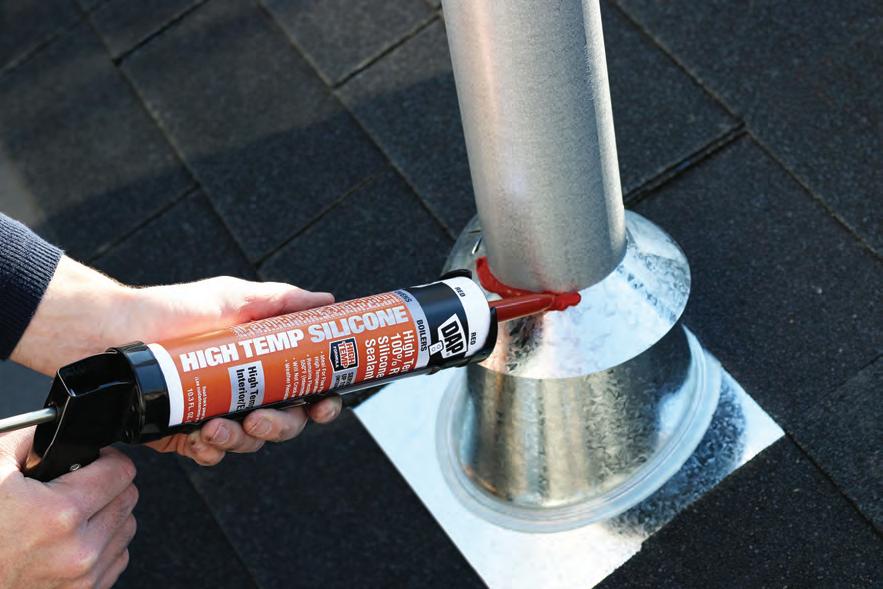









Professional 100% RTV Silicone Sealant FORMULA SERVICE TEMPERATURE -40°C TO 246°C Superior MultiMaterial Bond Strength 100% Waterproof / Excellent Weatherability Remains Flexible at High Temps, Will Not Crack or Shrink Safe For Incidental Food Contact – NSF Certified Superior MultiMaterial Bond Strength 100% Waterproof / Excellent Weatherability Remains Flexible at High Temps, Will Not Crack or Shrink Safe For Incidental Food Contact – NSF Certified High Temp 100% RTV Silicone Sealant FORMULA HIGH TEMP SERVICE TEMP 4.4°C to 287°C (INTERMITTENT) MULTIMATERIAL TEMP FLEX WEATHER RESISTANT HIGH FLEXIBILITY WEATHER RESISTANT MULTIMATERIAL NEW NEW www.dap.ca
BY ALLAN BRITNELL
REWARDING LOYALTY
Globetrotting Canucks can’t help but chuckle whenever they walk into a bar in some far-flung locale and spot a Canadian Tire dollar pinned to the wall alongside the national currencies of countries from around the world. Kudos to our compatriots who feel Sandy McTire, the Tam O’Shanter-wearing Scotsman who appears on the face of each bill, deserves pride of place alongside the Queen, George Washington and other historic figures.
Founded in 1958, Canadian Tire Money (CTM) is the country’s oldest loyalty program. But Canadian Tire has joined the digital age, as have its competitors in the hardlines business who are also looking to retain customers, gain valuable data on spending habits and streamline operations through loyalty programs.


BUYING LOYALTY
Canadian Tire Money represents loyalty programs at their most basic: shop in our stores and we’ll give you a percentage in “cash” back that’s redeemable on a future visit. It certainly helped promote repeat business. And the company benefitted from the occasional feel-good article in the news, such as the time an Edmonton man paid for a $1,000 riding lawn mower entirely in CTM.
But it was a static program that didn’t enable the retailer to gain any real insights into their customer’s spending habits.
So McTire went into semi-retirement in 2018 when Canadian Tire introduced the Triangle Rewards program. (Paper CTM is still available in stores for customers who are not Triangle Rewards members.) This cardand app-based program enables the company to track customers’ purchases in detail.
According to a 2017 Colloquy Loyalty Census, Canadians have more than 175 million memberships in various loyalty programs, a little more than half of those with retailers. Triangle accounts for about 10 million of those accounts and that number is growing under the company’s expanding suite of retailers including Mark’s and SportChek.
Customers earn 0.4 percent of pre-tax spending on qualifying merchandise and three cents per litre of gas for cash or debit card purchases. They also get up to four percent and seven cents per litre of premium fuel for purchases made with a Triangle World Elite MasterCard.
The company also offers their clients a variety of ways to earn bonus points and prizes. “Last year, Triangle sent members to see Canadian NHL teams play in Las Vegas, take in the MLB All-Star weekend in Cleveland and created an exclusive summer concert series with access to six concerts and two festivals,” says Gerry Ranking, Canadian Tire Corporation’s manager of loyalty.
CONNECTING WITH CONTRACTORS
While day-to-day consumers are important, a hardware retailer’s bottom line relies on attracting lucrative contractor clients who can easily spend hundreds of
Hardlines Home Improvement Quarterly www.hardlines.ca 46 FOURTH QUARTER / 2020 BEST PRACTICES
FLE
Loyalty programs help encourage repeat business— and provide retailers with reams of valuable data on consumer spending habits.
Founded in 1958, Canadian Tire Money is the country’s oldest loyalty program.
thousands of dollars a year on tools and materials.

Home Hardware’s Top Notch Rewards program for trades clients actually began under the Beaver Lumber banner in 1994 and was later adopted by Home Hardware when it took over the brand. More than 350 stores partake in the program across the country, primarily Building Centre locations, where members earn one point for every $20 spent.
“The points are redeemable for virtually anything,” says Michael Gawtrey, director of loyalty and CRM. “Members have redeemed more than 1,000 barbecues, 500 iPads, 200 bikes and a variety of outdoor vehicles. But we’ve also had some interesting redemptions including an engagement ring and a wedding dress.”
Home Depot Canada offers its contractor clients the Pro Xtra Program. When linked to a Home Depot Commercial Card, members receive one-percent cash back in quarterly rewards and up to 20 percent back on paint purchases. They can also track purchases up to two years back and there’s even a referral program that can generate new leads.
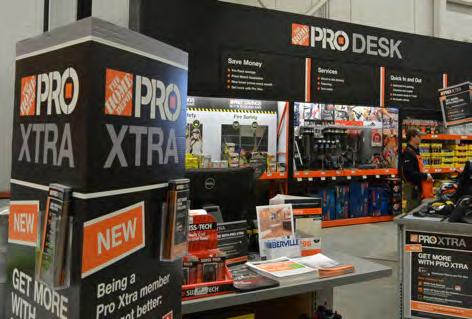
DATA MINING
For today’s retailers, loyalty programs go well beyond simply encouraging repeat business:
the electronic platforms provide a wealth of valuable data. “Collecting data on our pro customers is a continued focus so that we can better anticipate, meet and exceed their expectations,” says Gawtrey.
Of course, beyond improving the customer experience, Home Hardware uses this information for internal management. “We use the data to perform analytics to help our merchandising, marketing and operations team understand pro sales. This helps with managing the day-to-day and planning our pro business,” says Gawtrey. Data analytics enable the company to monitor incremental sales between participating and non-participating stores, customer retention and more.
Canadian Tire’s Ranking says, “Triangle data shows that a customer’s lifetime value and basket size increase as the member begins to shop across Canadian Tire’s family of companies.”
Additionally, “Triangle Rewards uses data at the forefront of all marketing initiatives. Triangle increasingly uses industryleading modelling and transaction history to serve members relevant and engaging content that maximizes their everyday program value. Data is at the core of our success and we rely on customer insights to continually provide a more personalized customer experience to our members.”
Of course, great data comes with great responsibilities. “Our customers expect us to protect their data and use it responsibly,” says Gawtrey. “Home’s Loyalty programs are guided by privacy practices such as PIPEDA and CASL.”
OUTSOURCING OPTIONS
Rather than developing their own rewards programs, many retailers offer their customers access to third-party rewards programs. Customers at Kent Building Supplies, Lowe’s Canada, TIMBER MART and RONA are all able to earn one Air Mile for every $15 to $20 spent in store.
As the name suggests, these earnings can be put towards flights, but the program also offers members the ability to convert their miles into cash or a variety of products ranging from children’s toys and housewares to electronics and jewelry.
Home Hardware offers their non-commercial clients access to the Aeroplan rewards program. Aeroplan has more than five million active members across the country. Home Hardware customers earn one mile for every $2 spent in store.
Participating retailers purchase those Aeroplan miles on their customers’ behalf. While declining to comment for this article, an Aeroplan spokesperson shared the following benefits for retailers participating in the program: “Our partners benefit from our ability to provide them with insights about the shopping habits of Aeroplan members. By leveraging the data across the program, we provide the opportunity to personalize offers, resulting in more value for our members.”
Whether it’s an in-house program or third-party offering, loyalty programs are an essential part of a retailer’s customer satisfaction and retention, marketing plan and overall business growth.
Hardlines
Quarterly www.hardlines.ca 47 FOURTH QUARTER / 2020
Home Improvement
Home Hardware’s Top Notch Rewards program for trades clients began under the Beaver Lumber banner in 1994 and was adopted by Home Hardware when it took over the brand.
Home Depot Canada offers its contractor clients the Pro Xtra Program.
COMPILED BY SIGRID FORBERG
DESPITE UNCERTAINTY, INDUSTRY LEADERS SEE OPPORTUNITIES AHEAD
Hardlines Home Improvement Quarterly www.hardlines.ca 48 FOURTH QUARTER / 2020
FEATURE
In this feature, we asked several industry leaders to share in their own words what they believe 2021 has in store for this industry. With a recession looming on the other side of the COVID-19 pandemic, the challenges ahead are clear. But in the midst of the crisis, home improvement dealers have proven the essential role they play in both the economy and as leaders in their communities.
committed to supporting its RONA dealers throughout this journey.
TONY HURST
President, Lowe’s Canada
So far, 2020 has been a strange year during which our industry was challenged in new ways and showed amazing resilience to unforeseen developments. No one knows for certain when we will return to a “postpandemic” world or what the new norm will be. However, one can think of a few key elements that dealers will need to navigate this new reality.
Undeniably, the pandemic greatly stimulated the digital revolution in retail. While many new consumers began shopping online, and will likely continue to do so, the expectations of seasoned online shoppers increased significantly, both in terms of greater product selection and transactional platform features. The real issue is no longer whether to offer online shopping or not, but rather the ability to provide a unique, distinctive online customer experience. With its industry-leading omnichannel capabilities, supplier relationships and supply chain capacities, Lowe’s Canada is
It can also be expected that the pandemic will have a lasting effect on our relationships with our employees and communities. It contributed to redefining employees’ expectations and aspirations towards their employers and their relationships with them, creating a new frame of reference for health, safety and well-being in the workplace and being an employer of choice. Similarly, the importance of being involved in our communities and being there for our neighbours has taken on a new dimension. Many of our customers and communities are suffering from the economic downturn, and our industry is doing better than many others. At Lowe’s Canada, we are committed to supporting our associates and our communities, and we are working with our dealers to take concrete action in that regard, including through the donation of more than $225,000 to help RONA affiliated dealers support store associates and local community needs.
Finally, while hardware and home improvement retailers have been fortunate to continue operations as essential services, the pandemic has been ruthless for many other industries. For dealers, this unfortunate situation offers great opportunities to acquire key locations and help vitalize their communities. Lowe’s Canada is keen to support dealers in this position by providing the logistical, human and financial capacities required for an expansion or consolidation project.
RUSS PERMANN
EVP & Chief Operating Officer, Taiga Building Products

When we contemplate the strengths of the industry, the first thing that comes to mind is adaptability. In the early days of the pandemic, there was much fear that the building supply industry wouldn’t be relevant as people grappled with losing their jobs and stayed home out of concern about contracting the virus. Instead, while people stayed home, they invested in the places where they planned to live and work over the coming months, which led to a sudden surge in demand for building materials and hardware. The industry had to adapt quickly and do so in an environment where none of us had a playbook. We had to learn to work remotely where we could, to build protocols to protect the safety of our people and the public and we had to find a way to remain financially viable through it all. Certainly, the pandemic isn’t over, but we’ve learned a lot about how resilient and adaptive this industry can be.

Hardlines Home Improvement Quarterly www.hardlines.ca 49 FOURTH QUARTER / 2020
LEADERS’ FORECAST
Having been deemed an essential service, the building supply industry found a way to continue meeting the needs of the DIYer and the contractor while also avoiding having any notable outbreaks or major disruptions due to the virus. That in itself is laudable.
At Taiga, we learned a lot about what it takes to operate an effective and consistent business under any circumstances. We’ve learned lessons that will live well beyond the pandemic. One of the key learnings for us is the value in technology investments; we are grateful that we made investments in our ERP and warehouse management platform over the last number of years because it allowed us to move all of our people who didn’t need to be physically present in our facilities into work from home arrangements without disrupting our ability to take orders, ship product and take care of all of the important administration required to run a big business. However, as we attempted to get everyone set up and working from home, we identified a number of hardware deficiencies that slowed down our progress in redeploying our people. We will therefore focus more on ensuring all of our people have the right technology at hand so that we can take advantage of the flexibility we’ve baked into our IT infrastructure going forward. Businesses that aren’t investing in the right technology as a priority are likely to find themselves vulnerable to future trends—expect to see us working even harder to integrate the supply chain and make it easier for our customers and vendors to reach us whether it be digitally on our soon to be released TaigaNow platform or through traditional technology.
The learning I mention last is actually the most important. The greatest strength of our organization and the industry through the pandemic is the people who make all of this happen every day. We couldn’t be more proud of how our people and the industry at large responded to this challenge. There was much concern and confusion in the early days of the pandemic as to what a business
FEATURE
should do to keep its doors open and make sure we protect the people working there; breaking our business down into cohorts, making a number of our corporate staff work full-time from home and finding a way to communicate more than ever were no easy tasks to complete but our people stepped up and executed well. I think our management might argue we’re at risk of overcommunicating today and thanks to Microsoft Teams, we’ve been able to engage almost as effectively as we did in person before the pandemic became our reality. That being said, one day this pandemic will be over, we’ll be safe moving about the market and we’ll get a chance to look everyone in the eye who did so much to keep our business and this industry going and thank them for what they’ve done.
and as a result we are working rapidly to meet the growing demand for our products and services.
E-commerce is projected to remain a critical priority of our retail operations as many Canadians are looking to shop from the safety of their homes. As such, we are investing in our e-commerce and fulfilment capabilities.
As we look to the future, we continue to be focused on supporting the dealers—and the services and support they provide to their local communities.
KEVIN MACNAB
President & CEO, Home Hardware Stores Ltd.

Through the global pandemic, Home Hardware has adapted to a new customer experience by being both agile and responsive in a new and uncertain market.
A key to our strength, both today and in the future, lies with our dealer-owned stores that provide essential services and support to over 1,000 communities across Canada. By ensuring our dealers have the right resources available, we’re able to navigate through this new normal together.
Home Hardware continues to adapt our operations to meet the demands of an ever-changing retail landscape. Operating in this current climate is unprecedented
ERIC PALMER
Vice President and General Manager, Sexton Group

I believe we have all read many intro lines that start articles by describing the global pandemic, or articles referencing the business climate changes as a result of the global pandemic. So instead, I will be brief—the pandemic changed our world and disrupted our lives. But through the disturbance, we witnessed the true strength of our network of connections.
The building supply industry was deemed a critical service during the very difficult early days of the pandemic, and because of that, we had to be one of the fastest acting industries. There was little time to slow down and determine how to keep the doors open. I watched as our dealers safely pivoted their business practices to serve the communities in which they are truly part of the fabric. The true independent nature of our members was on full display.
Economically, we are seeing a strengthening of the housing market following the
Hardlines Home Improvement Quarterly 50 FOURTH QUARTER / 2020
www.hardlines.ca
LEADERS’ FORECAST


3 1 2 KEEP OUTSIDE OUT. With the Northern Tri-Pane Collection™ featuring True Tri-Pane Technology™ Only JELD-WEN True Tri-Pane Technology™ can offer: Superior Efficiency Enhanced Home Comfort Exterior Noise Reduction And every Northern Tri-Pane Collection™ window is Canadian-made for Canadian climates. How much can you save your customer by switching to JELD-WEN? Use our calculator at KeepOutsideOut.com
FORECAST
sharp decline in Q1, and renovation spending is high. My belief is that we will see a slowing of this growth and an economic retraction in 2021. The forecasted decline in immigration will begin to dampen the housing market as it has been a major driver over the past number of years. The other economic factor is the risk of a second wave of COVID-19 cases. There is a strong potential that this will occur. However, with the many lessons learned from earlier this year, I believe we will see less economic impact and fewer full provincial shutdowns, which are very disruptive.
As a buying group, we have been solely focused on our members’ needs. And that means helping them minimize the disruption to their business, particularly when it comes to product supply. One of the major issues facing all building supply dealers in Canada is the interrupted supply chain. Securing both rail and truck freight has proven to be difficult and unstable. In addition to the shipping issues, there is an unbalanced demand versus supply issue. If you look at lumber, OSB and plywood, demand is far outpacing supply. This is happening as consumers are consuming products in non-traditional demand curves. While treated lumber has become the new toilet paper, manufacturers and mills are cautious about bringing on too much capacity, simply to see demand trail off in early 2021. Many individuals decided on a new deck instead of a cruise and this increased demand is crippling the system. With high demand and little supply, the additional concern is pricing. Our guidance for many members is to consider shorter expiry dates on quotes as product pricing is very volatile. I anticipate this disruption to continue well into 2021.
Many of our best laid plans for 2020 were halted in March, but quickly new plans were in the works and underway. Sexton members and our Sexton team swiftly adapted to ensure success in 2020. We and our members are well on our way to driving that success into 2021.
KEN JENKINS

President, Castle Building Centres Group

The resiliency and adaptability of entrepreneurs never ceases to amaze me. The i ndependents in the home improvement space not only adapted to a rapidly changing business environment, many of them have thrived. It continues to underscore how vital this segment is to the economy and our communities across our country.
Whenever global events occur that lead to Canadians staying close to home, our industry benefits. We experienced this post-9/11 and following the financial crisis in 2008. When compared to several other industry segments, ours has faired extremely well. We should all consider ourselves fortunate.
The current issues of labour scarcity and product availability in our industry have further challenged the entrepreneur and their capabilities. However, rather than succumbing to the challenge, many independent entrepreneurs have increased sales, grown margins and added market share in 2020. A simply remarkable accomplishment, but not unsurprising based on their connections to their respective communities.
Success is never achieved alone. While many product segments are under duress based on demand, our supplier network within the home improvement segment needs to be acknowledged. The onset of COVID-19 and the unknown variables in late March and early April would have led few to believe we would enter a period of unprecedented demand in many product categories. We truly appreciate the efforts made to enable the success of our members during these challenging times.
To the women and men who continue to persevere as entrepreneurs in the LBM and hardware segments of our industry, your value to community and customers continues to shine. It is humbling to witness the effort, energy and passion you exhibit. Regardless of banner or brand, you should take great pride in your accomplishments.
BERNIE OWENS
President & CEO, TIMBER MART
Whether it be residential homes or commercial buildings, large renovations or small home projects, the building supply and hardware industry is fortunately considered “essential” to the well-being of home and business owners.
Independent dealers are resilient, nimble and able to adapt quickly to changing market conditions and consumer demands. Independent dealers also have a high level of customer intimacy that allows them to provide personalized service and form lasting relationships that sew them into the very fabric of their communities.
Amid the economic uncertainty that continues to underscore our new normal, independent dealers will need to continue to draw on these strengths as well as keep a close eye on their cash flow, house-account dating and inventory turns, while ensuring that they are buying and selling competitively in their local markets.
Joining a low-cost buying group that is acutely focused on providing dealers with a competitive advantage is one of the best moves an independent dealer can make, especially during uncertain times like we’re experiencing now.
Hardlines Home Improvement Quarterly www.hardlines.ca 52 FOURTH QUARTER / 2020
LEADERS’
FEATURE

INDUSTRY PARTNER IN STORE RENOVATION OUR PURPOSE To drive innovations to support the ‘Bricks and Mortar’ retail industry (Both Retailers and Manufacturers) to ensure it remains relevant & profitable in the face of online retail & the new class of competitors it creates. Everything we do drives uniqueness, sales and profitability for our clients. www.bmfonline.com SARAH HOUNSLOW VP Sales & Marketing 905-407-6030 | shounslow@bmfonline.com Burlington Merchandising and Fixtures Inc Graphic design & signage Installation Service counters Store planning Store fixtures LBM displays
LOWE’S NEW CALGARY-AREA DC WILL BE BIGGEST IN WESTERN CANADA
Lowe’s Canada has unveiled plans to open a giant distribution centre in the greater Calgary area. The facility, which will be 1.23 million square feet in size, is expected to open in the fall of 2021.

According to Lowe’s Canada, the project is part of its plans to optimize its distribution network to manage growth from both in-store and online business. That includes the buyback of its head office in Boucherville, Que., which the company did at the end of April.
The DC will become part of a network supplying more than 470 corporate and affiliated stores under Lowe’s Canada’s different banners. Calgary-based Highfield Investment Group, which manages residential and commercial real estate, has entered into a definitive agreement for the construction of the new DC in the High Plains Industrial Park, in Rocky View County northeast of Calgary. The area is considered a hub in the West for distribution centres and e-commerce
retailer currently operates four DCs in the Calgary area: one main DC located at 60 Street SE in Calgary, and three satellite centres that are used for handling big and bulky items.
The existing Calgary DCs serve both Lowe’s and RONA stores, including RONA affiliated dealer stores. However, the Lowe’s selection moving through these sites is lim-
will be significantly enhanced, which will allow us to serve more efficiently our corporate and affiliated stores, as well as our customers in the Western Canada region,” says Valérie Gonzalo, a spokesperson for Lowe’s Canada.
The new facility is expected to significantly increase the product selection available for rapid deployment to both RONA and Lowe’s stores in Western Canada.
“This new distribution centre will allow us to substantially enhance our distribution network capacity and serve our Lowe’s and RONA corporate stores and customers, as well as our RONA affiliated dealers, more efficiently throughout Western Canada,” said Gregor Stuart, senior vice-president, supply chain at Lowe’s Canada.
fulfilment facilities. The Lowe’s facility will reportedly be the largest leased DC in Western Canada, representing a total joint investment of more than $120 million.
The facility will consolidate the capacity of several existing Lowe’s Canada satellite warehouses and regional distribution centres located in the Calgary market. The
ited. The new, built-to-suit facility will consolidate the three satellite DCs, while providing additional capacity for future growth.
The 60 Street SE distribution centre will not be impacted by this project and will remain in operation. It will be used to manage smaller units and case pick assortments.
“Overall, our distribution network capacity
Even Alberta Premier Jason Kenney weighed in. “This is great news for Alberta. The construction of the new Lowe’s Canada distribution centre will create jobs for Albertans when they are needed most,” he said, adding that the project “demonstrates a vote of confidence in our province’s future.”
Hardlines Home Improvement Quarterly www.hardlines.ca 54 FOURTH QUARTER / 2020
FLE NEWS SPOTLIGHT
Overall, our distribution network capacity will be significantly enhanced, which will allow us to serve more efficiently our corporate and affiliated stores, as well as our customers in the Western Canada region.
“ ”
Lowe’s Canada continues to refine its distribution network, with plans to consolidate satellite warehouses and RDCs in the Calgary market.
“We have been a member of TORBSA since 1971. In 2021 we will be celebrating our 50th year in business and have always been a proud member of TORBSA. The strength of this buying group is connected to our ability to work directly with the vendors, as well as maintaining close working relationships with other independent owners. TORBSA has kept us competitive and ensures full transparency. Our affiliation with TORBSA has guaranteed success in our business and has enabled us to create meaningful and lasting relationships with our fellow members and vendors.”
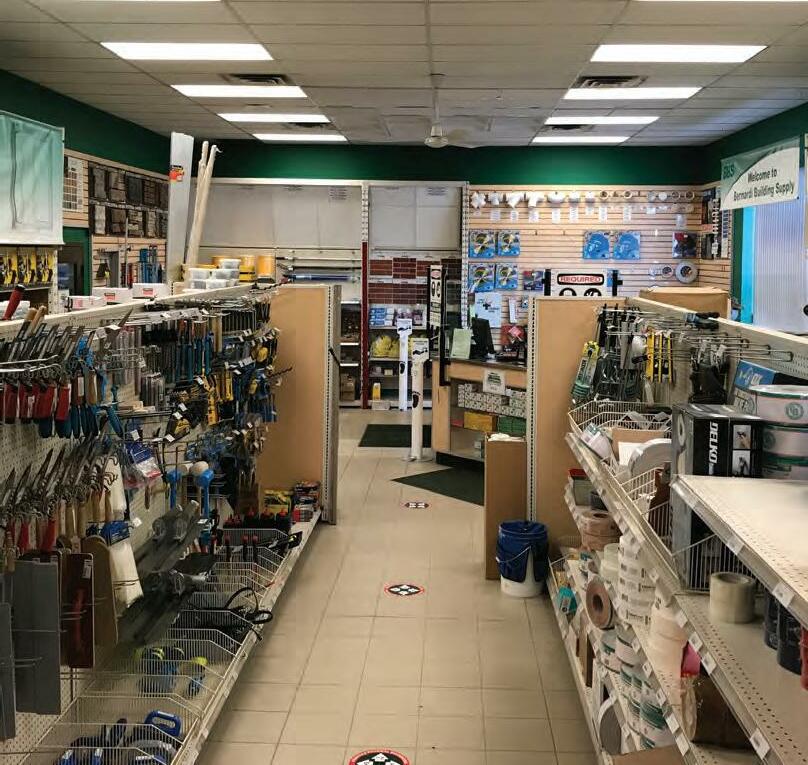

MEMBERSHIP MEANS OWNERSHIP
For More Information about TORBSA, Call Paul Williams at 1-866-865-1689 www.torbsa.com
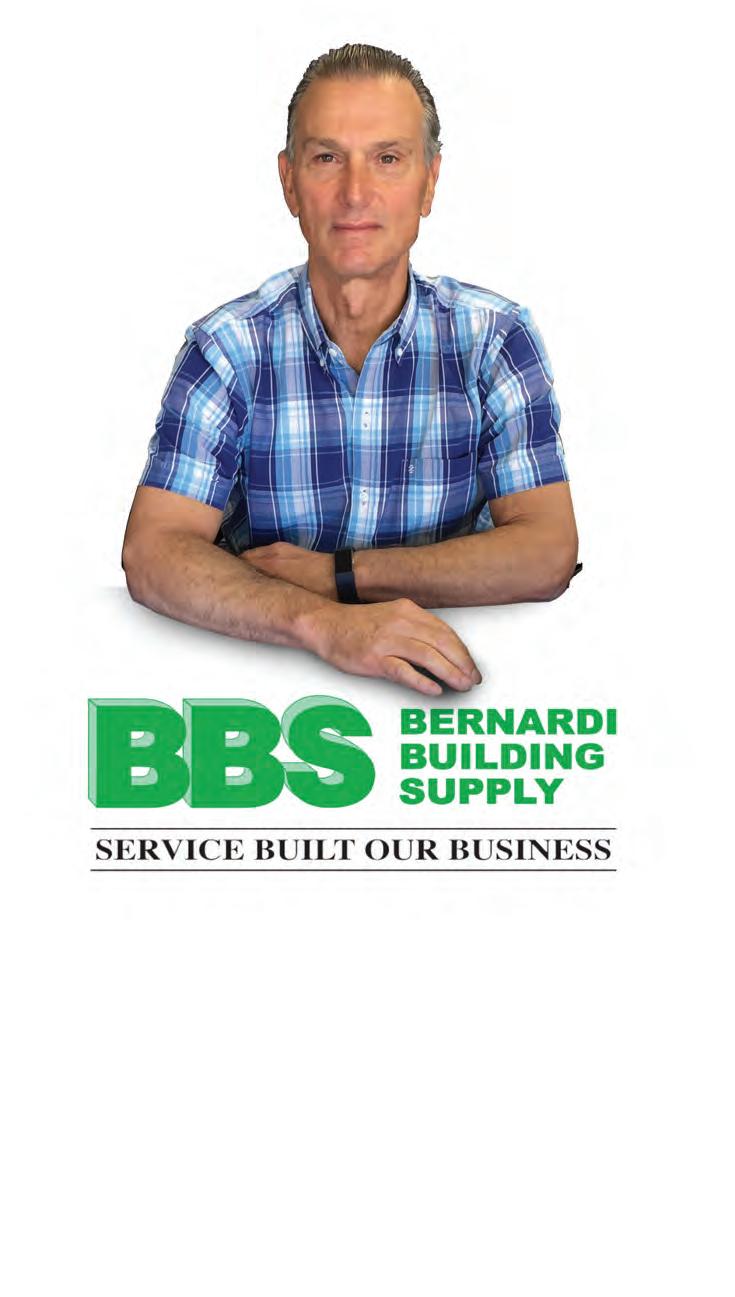

 PAUL BERNARDI Vice President
Bernardi Building Supply Toronto, Ontario
BY ROB WILBRINK
PAUL BERNARDI Vice President
Bernardi Building Supply Toronto, Ontario
BY ROB WILBRINK
USING DATA TO DRIVE PROFITABLE CHOICES
Even
The decision by chains such as Canadian Tire and Lowe’s Canada to put a pause on all door-to-door flyers during the lockdowns due to the rise of the COVID-19 pandemic has brought me back to my time working for Lansing Buildall. We relied heavily on flyers to drive traffic to the company’s eight Toronto-based stores. We wanted to make our flyer program more efficient. To do this, we merged three databases in a unique way and achieved some incredible results. While the temptation might be to relegate these finding to the dust bin of history, the reality is that the concepts are equally relevant to marketing efficiency in the digital age.
The first database was from Compusearch Psychographics, which categorized consumers into 60 different demographic profiles called PSYTE clusters. These were grouped by such factors as education, profession, culture, family structure, income level, housing type, ethnicity, values and age. The second database was gathered by our cashiers, who collected postal codes linked to more than 100,000 transactions across all eight locations. The total value of each transaction coupled with a postal code gave us each customer’s distance from the store and their associated PSYTE cluster.
Using concentric circles around each store in one-mile increments, we were able to determine how many households of each PSTYE cluster were in each ring and therefore the percentage of those shoppers who had shopped in our stores. From this, we calculated the propensity for each household to shop our store, link it to their average transaction value and even project a likely frequency of visiting our stores, based on their profile and distance from our stores. We now had the data we needed to rank the relative value in dollar terms for each household in our market. To adjust for seasonality, we applied these relative values to the total sales for each store to determine an actual dollar value for each household.
With this information, we approached Metroland, which delivered local newspapers to virtually every household in the GTA. They agreed to merge their database with our Compusearch find-
ings so that PSYTE profiles were linked to each carrier’s route. We could now directly target our flyers for greatest return. The results were outstanding: we reduced our flyer distribution from 740,000 to 510,000, and sales across the chain grew by 10 percent.
We subsequently used this data to rank the viability of 50 potential new site locations across the GTA. We were able to predict the actual sales each location could generate. Unfortunately, we were never able to test the model on a new site of our own before the company was sold. We were, however, able to verify the veracity of the model by testing it against annual sales of our existing sites.
Interestingly, a competitor entered the market with great fanfare and happened to choose the lowest-ranking site on our list. It was in a busy part of town, but the distance and demographics of local housing stock suggested the store had no chance of success. Even though it was a great-looking store, it never came close to hitting sales targets and was closed three years after it opened.
This data is now 25 years old and tools for effective targeting of customers have come a long way. The concepts, however, are more important than ever. The rapid growth of online competition leaves no room for costly gut decisions on marketing spend or site selection by bricks-and-mortar retailers. Fortunately, data and tools for analysis are much easier to access then they were in 1995!
Rob Wilbrink is the president and CEO of Burlington Merchandising and Fixtures (BMF). BMF provides a full range of services for independent dealers, including category strategy development, store layout and design, assortment planning, project management, design, supply and installation of store fixturing and signage, carpentry and merchandising.
Hardlines Home Improvement Quarterly www.hardlines.ca 56 FOURTH QUARTER / 2020 MERCHANDISING
in the digital age, we don’t have to toss out all our analog best practices. With the technology of today and the strategies of yesterday, you can make your marketing more efficient and significantly more successful.
FLE
Safety. Reliability. Energy Efficiency. Sécurité. Fiabilité. Éfficacité Énergétique.
Water Heaters Chauffe-eau

Across Canada, the GSW brand of water heaters are recognized for their excellent safety, efficiency and reliability. In fact, GSW takes the guess work out of buying a water heater. GSW has become an industry-leader and a mainstay in homes across Canada.

Partout au Canada, les chauffe-eau GSW sont reconnus pour leur grande valeur, leur haute efficacité et leur fiabilité. Voilà pourquoi il y a plus de chauffe-eau GSW installés partout au Canada que toute autre marque.
www.gsw-wh.com
BY JOHN CAULFIELD
DOWN, BUT NOT OUT
WELCOME
In early April, the Ontario government, in its efforts to stem the spread of the novel coronavirus, narrowed its designation of “essential” businesses and services. That forced John Kuepfer, like other hardlines and building products dealers, to temporarily close the showrooms of his two Wellesley Home Centres to shoppers.
Those restrictions lasted 50 days, during which Kuepfer—who co-owns the company with his daughter Megan Brubacher— modified his operations for curbside ordering and delivery. (He claims his store was the first in the Waterloo region to do that, two weeks before the provincial decree.)
Kuepfer also shifted his ads from products to informing customers what to expect when they came to his stores. In June, he experimented with flyers that promoted the stores’ services.
The result: Wellesley Home Centre had record sales every month from March through July—particularly in paint, lawn
and garden and pressure-treated wood. Other dealers struggled, observes Brubacher, because “they didn’t adapt quickly enough to make their staff feel comfortable.”
That’s the story, with some variations, that other home improvement dealers tell about how their businesses have fared during the pandemic. They say this event has tested the fortitude of their employees who had to adjust on the fly to unfamiliar ways of selling and customer service. The pandemic also gave dealers the chance to demonstrate their care for associates and customers.
“Our staff really stepped up,” says Scott Beaumont, president of Lyons Ltd. in Sault Ste. Marie, Ont., which operates three TIMBER MART stores in Ontario. “Every four weeks there was another bump in the road.” (When HHIQ spoke with Beaumont in July, the Ontario government had just mandated mask wearing.)
Lyons Ltd. has more than 100 employees and has kept most of them working throughout the pandemic. When Beaumont closed
his showrooms to the public, he installed a video-feed system at all three stores that allowed customers to place orders from outside. Some employees wrote down the orders, while others picked and assembled products. Beaumont says that fulfilment was “pretty quick” but was also “taxing on our staff.”
After reopening its showrooms, Lyons limited the number of customers in its stores at any given time to 10 to 15 in the two larger outlets, and five in the smaller store.
Some dealers took a while to get the bugs out of their curbside service. Charlie Hotham owns Windsor, Ont.-based Hotham Building Materials, whose three locations specialize in concrete/masonry, insulation and sealant/waterproofing products for industrial/commercial customers. Over the years, the stores’ retail business has increased.
Closing the showrooms for nearly six weeks created some stress on his employees, Hotham recalls, partly because the descriptions that customers gave when ordering
Hardlines Home Improvement Quarterly www.hardlines.ca 58 FOURTH QUARTER / 2020
FLE SELLING TO PROS
HARDWARE BUILDING CENTRE
Retailers have gotten through the pandemic, thanks mostly to their teams’ adaptability.
didn’t always match what they wanted— especially for tools. “Our people sometimes had to make five or six trips in and out of the store,” says Hotham.
The pandemic presented other challenges as well. Hotham points out that when general contractors experienced snags in purchasing ready-mix concrete from factories (which requires a proof of a jobsite permit), that put a “crimp” in Hotham’s sales of other products for that project.
Gary Sangha, general manager for TORBSA-affiliated Crown Building Supplies in Surrey, B.C., notes that while his company was able to deliver during the pandemic, it ran into restrictions that limited how many people could be on a jobsite at a time. “So our delivery trucks sometimes had to wait,” he says.

On the other hand, Sangha is fine with curbside pickup. He says that even before the pandemic, Crown had been urging its pro customers to place orders a day or two in advance of picking them up, to relieve the traffic jam that occurs when “everyone is trying to get product at the same time” every morning.
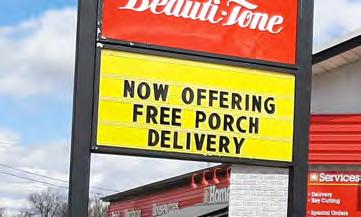
A SAFER PLACE
During the pandemic, Hotham has had regular meetings with his employees to make sure they were carrying out COVID19 protocols. His company took precautionary measures around physical distancing, installed checkout barriers, limited the number of customers in the showroom to no more than three at a time and placed sanitizers at entrances and exits.
Westrum Lumber, with four locations in Saskatchewan, has tried to keep its 51 employees at safe distances from each other, says owner Mark Westrum. “We separated them as best we could into offices, put up dividers between desks, and established a walking traffic pattern.” However, getting customers to physically distance once the showrooms reopened was easier said than done. “Seniors are the worst offenders,” laughs Westrum.
He estimates that his company’s revenue will be off somewhere between 10 and 15 percent this year. Fortunately, his company had cash reserves that allowed it to weather the loss of foot traffic for a few months. And as his stores have returned to something resembling normal, Westrum says daily sanitization has become an ongoing activity. He’s not so sure about whether his customers will be as diligent once the virus subsides or a vaccine emerges. Already, he says, “I can’t tell you the number of people who walk by the sanitizer [dispensers] at the front of each store.”
Retailers have taken away some valuable lessons from this experience. “We learned that we’re pretty central to people’s wellbeing,” says Beaumont of Lyons Ltd. Sangha of Crown Building Supplies says his company has come to appreciate the importance of communication with its 65 employees. “People need to feel safe and secure, and that they are protected.”

Sangha adds that one virus-induced change that might become permanent is how Crown interacts with manufacturers’ reps, with whom it has been talking primarily via Zoom meetings during the pandemic. “The head honchos at these companies are all seeing how much money they’ve been saving” by not having reps travel to clients. “Maybe we can do Zooms four times a year, instead of meeting with reps [physically] two or three times.”
Communication wasn’t the only part
disrupted,
as shortages in certain building products have persisted. Westrum says his stores have had to “push out” orders for decking, partly because lumber mills laid off workers during the virus spread, which limited harvesting.
Sangha says Crown continues to have trouble obtaining drywall and insulation. “You have to order well in advance.” And he believes it could be a while before those suppliers ramp up their production, especially if they worry about a second virus wave this fall or winter.
Hardlines Home Improvement Quarterly www.hardlines.ca 59 FOURTH QUARTER / 2020
of the supply chain that the pandemic
however,
Charlie Hotham has regular meetings with employees at all three of his stores to ensure they’re carrying out COVID-19 protocols.
John Kuepfer closed his doors and offered curbside pickup two weeks before it was mandated by the Ontario government.
BY LYNDON MADDEN
COMMUNICATING ACROSS GENERATIONS
While age and demographics influence how people communicate, marketing expert Lyndon Madden argues one’s preference is much more personal. Learning more about your coworkers may be just what you need to bridge the gap.
here’s no shortage of names and labels we put on generations.
As with many names we give to groups of people, it doesn’t help. Instead, it divides us into groups, which can be judged without taking the time to understand an individual. My advice is to strip away the
generational labels and take the time to understand the person you’re dealing with on an individual basis.
Often, the depth of character in those we work with can surprise us. So don’t call them millennials, oldies, gen X, Y or Z. Consider each individual simply as
someone who is travelling the same road as you, but is simply at a different point in their journey compared to you.
As a mid-career man in my 40s, I find myself in the middle of two demographics. How I communicate with them may differ slightly and needs to be assessed on
Hardlines Home Improvement Quarterly www.hardlines.ca 60 FOURTH QUARTER / 2020 STORE MANAGEMENT FLE
T

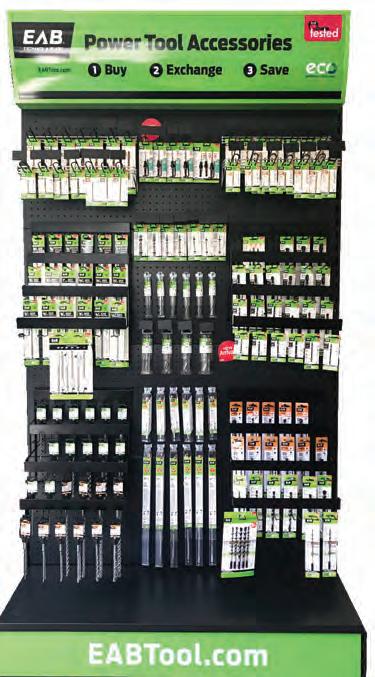

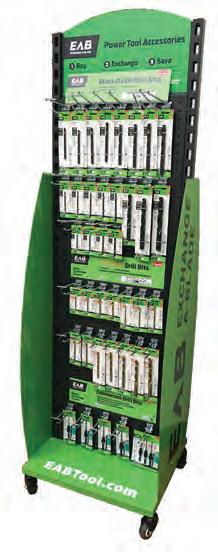
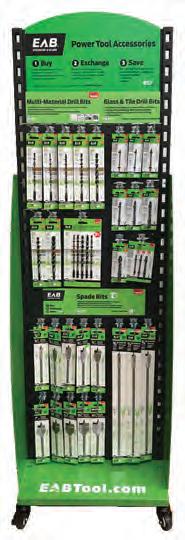
The ONLY COMPLETE line of Exchangeable Drill Bit program in North America, save money and the environment! NEW Exchangeable Drill Bit Program 4' 3' 2' Contact your EAB representative for details 1 800.663.2510 Drill Bits For: Wood Metals Plastic Concrete Masonry Tile Stone And more...
a person-by-person basis. I have met more than my fair share of older folks who surprise with their fresh and innovative ways of working, and I have also met younger colleagues who surprise me with their depth of focus.
So how do we bridge the gap? Often, how you work with others is just not enough to make communication work. You can’t simply get great working relationships with people by doing a good job and being good at relaying information. If this whole COVID-19 period has taught us anything, it would be that we need a certain amount of human connection.
A great tip as a result, for every person you deal with, regardless of age, is to bring in enough personality to let them know you are an individual. I’m not suggesting you get into sharing all your deepest, darkest secrets, but it’s OK to have more than a casual surface-level type of exchange. This type of casual chatter doesn’t really facilitate the human connection we all need. If someone asks how you’re doing, try giving some real information in your reply. You will teach them a bit about yourself and they will likely do the same in return. This will help build rapport.
If you think this is a bit much, ask yourself: have you ever taken a moment to think what a colleague does when they go home?
Acknowledging your coworkers’ individuality helps humanize them and can go a long way in bridging the gap. And it can help smooth over any issues that crop up. And vice versa, a bit of sharing can help someone know who you are as a person and remind them that you’re not just some robot who plugs in at night and works during the day.
You’ve gotten as far as trying to develop a human connection. This should help you to learn to communicate with them more openly. If you think communication isn’t a big part of your job, think again. I know I enjoy gathering experience from my elders and seeing how they look at things, as well as taking energy and enthusiasm from younger folks. Both groups can fuel me.
The next step is understanding how people want to communicate. This can be very tricky because it can be quite personal. Many members of younger generations are very comfortable with electronic communication. They’re not alone—people of all ages seem to enjoy the simplicity of typing something up, hitting send and considering the job done. Well, news flash: the job is not done. When it comes to communication, saying something is only the first step. Truly making an effort means that you have to ensure the recipient understands your message. Flat out, there is no use in half-communicating. And the responsibility for ensuring the message is understood falls equally on both parties. The recipient needs to put in the effort to try to understand the message in its full meaning.
Everyone picks up knowledge in different ways: some comprehend by reading or seeing, some by hearing and others through hands-on experience. Figuring out what each colleague, or recipient, responds to is an art in itself—yet learning this is a powerful tool in your communication toolbelt.
In the effort to communicate outward properly, there are a few keys to remember. Have a point, make it clear why this is important and be concise about what actions you want. This sounds obvious, but in practice is
not. We have all been confounded by someone speaking, or writing without a clear point, relevance or call to action.
In moments when I feel what needs to be communicated is delicate, or important, I will write what I have on my mind then go through and see if I can remove words. The goal is to sharpen my communication until I get to the clearest expression of my point possible. You may find if you take time to do the same, you can get more to the point, and you can distill your words down. Further, doing this frequently enough, you can start to change the way you communicate in all forms. Keep going with this to keep your communication contemporary for current generations and the ones to come.
To summarize: drop the generational stereotypes. Make the attempt to build some rapport to facilitate better communication. Take ownership of the complete process of communicating and being understood. Learn how your intended audience understands best either by hearing, reading or possibly by being involved in the process. When communicating outward, have a point, make it clear why it is important and what actions you want in response. Constantly work to refine your communication. It is an endless pursuit and an evolving objective.
Lyndon Madden is consumer goods marketing executive, who has worked with many small and large brands through his career. He is passionate about bringing thoughtful business strategies and building long-term brand success. He has more articles on communication and leadership available through his LinkedIn profile.

Hardlines Home Improvement Quarterly www.hardlines.ca 62 FOURTH QUARTER / 2020 STORE
MANAGEMENT FLE
Everyone picks up knowledge in different ways: some comprehend by reading or seeing, some by hearing and others through hands-on experience. Figuring out what each colleague, or recipient, responds to is an art in itself—yet learning this is a powerful tool in your communication toolbelt.
“ ”
ADVERTISERS: FOURTH QUARTER / 2020
Auto-Stak Insert www.autostak.com
BMR Group 6 www.bmr.co
Burlington Merchandising & Fixtures (BMF) 53 www.bmfonline.com
DAP 45 www.dap.ca
Diablo Tools 8 www.MoreCutsLessTime.com DuPont 21 www.BeyondBlue.DuPont.com
EAB Tool Company 61 www.eabtool.com
GSW 57 www.gsw-wh.com
Hardlines 35 www.hardlines.ca
Home Hardware Stores Ltd. 4 www.Home-Owner.ca
King Marketing Ltd. 3 www.kingmkt.com
Jeld-Wen 51 www.KeepOutsideOut.com
Mi5 Print and Digital Communications 63 www.mi5print.com
NHPA Canada 65, 67 www.nrha.org
Orgill Canada 22, 23 www.orgill.ca/about-us
Richelieu Hardware 2 www.richelieu.com RONA 19 www.rona.ca/becomeRONA
Sexton Group 39 www.sextongroup.com
Taiga Building Products 17, 68 www.taigabuilding.com
TIMBER MART 27 www.timbermartmember.ca
TORBSA 55 www.torbsa.com
Western Retail Lumber Association Inc. (WRLA) 29 www.wrla.org/education
Hardlines Home Improvement Quarterly
64 FOURTH QUARTER / 2020
www.hardlines.ca
IN THE NEXT ISSUE OF HHIQ: AD INDEX Winning the retail war: After the ORAs PLUS: Conversations with contractors; Navigating COVID: What now?; The future of the trade show Publication Date: January 15, 2021 • Ad Reservations: November 27, 2020 (contact david@hardlines.ca) • Ad Material Due: December 11, 2020 HOME IMPROVEMENT QUARTERLY

TeamBuilder A North American Retail Hardware Association product, in partnership with Retail People Solutions Is your team in sync, or just trying to stay afloat? Improve your team’s productivity and communication skills with NRHA’s TeamBuilder assessment, which provides you with a customized strategy for your business and people. Learn more at nrha.org/teambuilder
BY GEOFF Mc LARNEY
YOU CAN GO HOME AGAIN
Ryan Buck has heard opportunity knock from as far away as California, but it’s in the family business he grew up in that he’s found success.
Although Ryan Buck grew up in the hardware business, it wasn’t where he expected his career to end up. Yet at 34 years old, he’s already the coowner of two successful Home Hardware stores in Nova Scotia’s South Shore region. This past spring, the NRHA recognized him as one of its Young Retailers of the Year in the Multiple Stores category.

“It’s the old story: the small-town kid always wanted to get out to the big city, but you always end up coming back,” Buck reflects. “No matter how many times I left, I kept coming back.”
Buck’s parents, Brian and Janice, settled in the town of Bridgewater in 1983, when Brian took a job as assistant manager at what was then the new Lockhart’s building supply store. The Bucks assumed ownership in 2001.
After a couple of years at university in Ontario, an illness obliged Buck to move home.
“I worked at the store for a little bit, and I had a job lined up at a Hilton hotel in San Diego,” he recalls. “I went on site visits and enjoyed the interactions with people, the problem solving.”
The Hilton gig soon fell by the wayside. Buck finished his studies in Halifax and after starting a family, put down roots in the family business. Ultimately, he and his wife Julie took over the business last January.
With the addition of a store in nearby New Germany in 2019, the Bucks found themselves serving two distinct communities. Buck says the Bridgewater clientele is about 80 percent pros. In smaller New Germany, there is a wider variety. This summer, they broke ground on an 8,500-square-foot second warehouse to help meet their needs.
“We know lumber, lumber is in our blood, but there’s a lot more opportunity on the softer side of hardlines,” he explains. With a number of cottages in the area, he adds, activity there is “very seasonal.”
The region is well-served by multiple banners from Walmart to fellow Home Hardware members, but the Bucks’ stores hold their own thanks to their dedicated staff, customer care and strong community ties.

“To me, retailing is more than just selling lumber and paint and door locks,” Buck reflects. “It’s what you do in your community. I was a volunteer firefighter for seven years. My wife and I have started two scholarships—one for each store—for the local high schools.” Each one goes to a talented student who is active in the community: “exemplifying what we hope we exemplify.”
“My wife’s and my philosophy is to leave the community a better place than we had
growing up. If we can contribute to making it a better place, we’ve achieved what a small business should be doing.”
Fostering relationships is just as critical to the store’s internal operations as it is to community interaction.
“This business, like anything, is all about relationships,” says Buck. “You build the relationship; you have a team that you empower to make decisions and train them. I’m a firm believer in not micromanaging anyone. I love engaging with my team. At the end of the day, the staff makes the business.”
Hardlines Home Improvement Quarterly www.hardlines.ca 66 FOURTH QUARTER / 2020
ENDCAP FLE
Ryan and Julie Buck work to give back and improve their small community on Nova Scotia’s South Shore.
The Bucks opened a second store in New Germany in 2019.

Congratulations to our partners at Hardlines Thank you for serving the home improvement industry for 25 years and counting! To learn more about the association, visit nrha.org.































 SIGRID FORBERG, EDITOR
SIGRID FORBERG, EDITOR








 MICHAEL MCLARNEY, FOUNDER & PRESIDENT
MICHAEL MCLARNEY, FOUNDER & PRESIDENT





























 BY
BY





































































































































 VICE PRESIDENT & PUBLISHER
VICE PRESIDENT & PUBLISHER






































 PAUL BERNARDI Vice President
Bernardi Building Supply Toronto, Ontario
BY ROB WILBRINK
PAUL BERNARDI Vice President
Bernardi Building Supply Toronto, Ontario
BY ROB WILBRINK















